A Critical Analysis of Various Theories, Models, and Strategies
VerifiedAdded on 2019/12/17
|19
|6986
|148
Essay
AI Summary
The provided content consists of various academic articles and books related to leadership, management, organizational change, employee motivation, and responsibility. The articles explore topics such as leading through change, managing virtual teams, implementing excellence in healthcare organizations, and motivating employees. Additionally, there are studies on attachment orientations across relationships, credibility, and the challenges of leading during times of change.
Contribute Materials
Your contribution can guide someone’s learning journey. Share your
documents today.
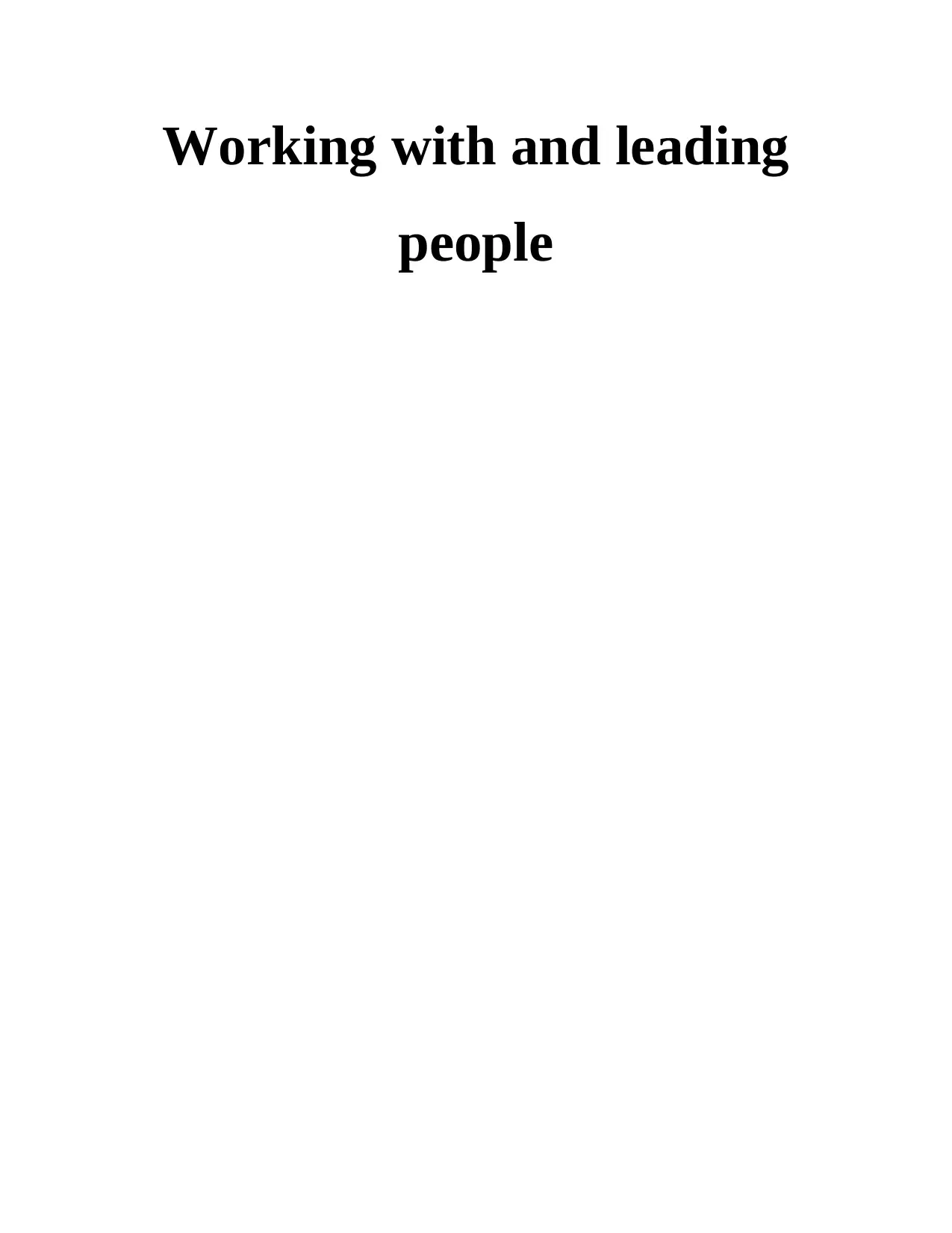
Working with and leading
people
people
Secure Best Marks with AI Grader
Need help grading? Try our AI Grader for instant feedback on your assignments.
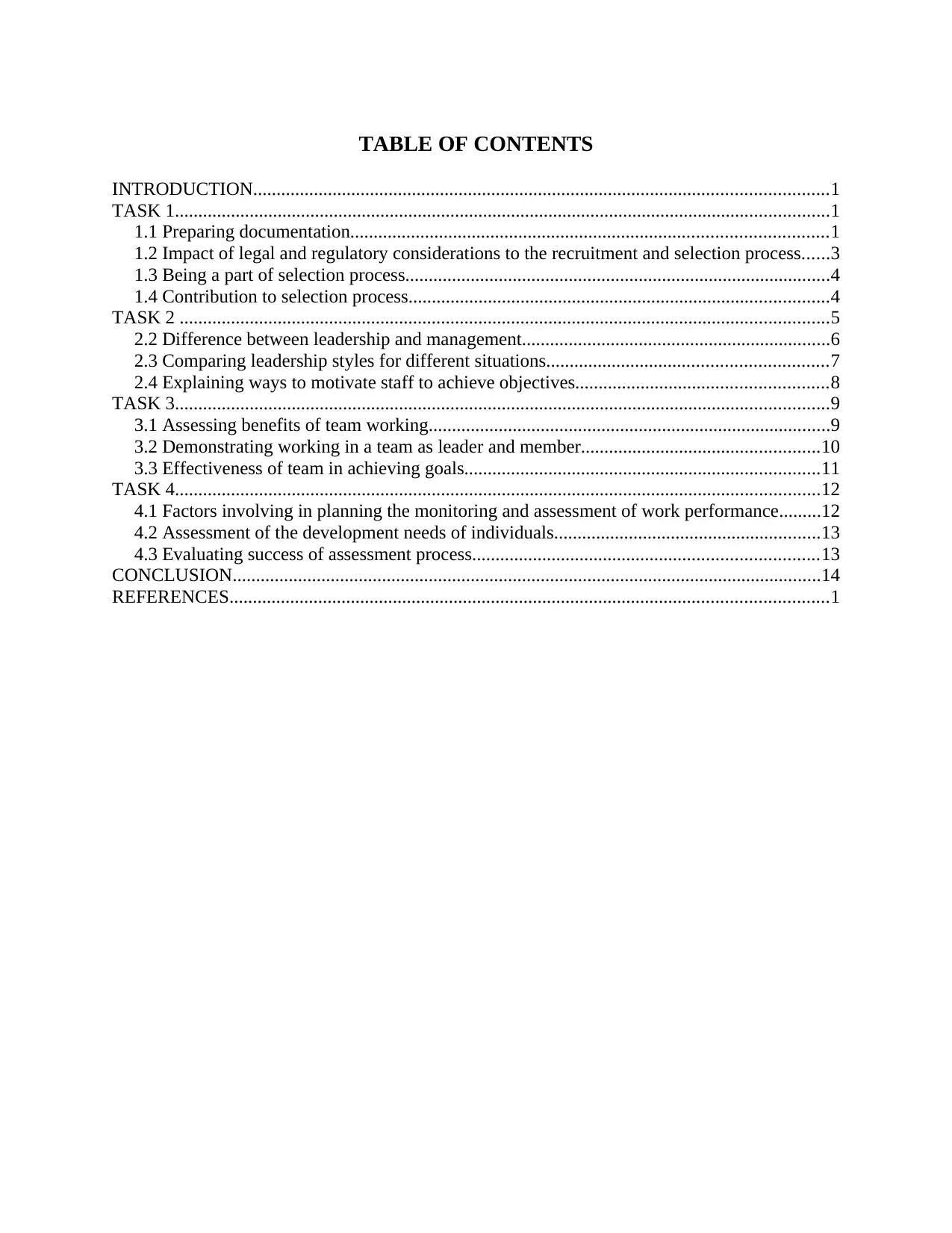
TABLE OF CONTENTS
INTRODUCTION...........................................................................................................................1
TASK 1............................................................................................................................................1
1.1 Preparing documentation......................................................................................................1
1.2 Impact of legal and regulatory considerations to the recruitment and selection process......3
1.3 Being a part of selection process...........................................................................................4
1.4 Contribution to selection process..........................................................................................4
TASK 2 ...........................................................................................................................................5
2.2 Difference between leadership and management..................................................................6
2.3 Comparing leadership styles for different situations............................................................7
2.4 Explaining ways to motivate staff to achieve objectives......................................................8
TASK 3............................................................................................................................................9
3.1 Assessing benefits of team working......................................................................................9
3.2 Demonstrating working in a team as leader and member...................................................10
3.3 Effectiveness of team in achieving goals............................................................................11
TASK 4..........................................................................................................................................12
4.1 Factors involving in planning the monitoring and assessment of work performance.........12
4.2 Assessment of the development needs of individuals.........................................................13
4.3 Evaluating success of assessment process..........................................................................13
CONCLUSION..............................................................................................................................14
REFERENCES................................................................................................................................1
INTRODUCTION...........................................................................................................................1
TASK 1............................................................................................................................................1
1.1 Preparing documentation......................................................................................................1
1.2 Impact of legal and regulatory considerations to the recruitment and selection process......3
1.3 Being a part of selection process...........................................................................................4
1.4 Contribution to selection process..........................................................................................4
TASK 2 ...........................................................................................................................................5
2.2 Difference between leadership and management..................................................................6
2.3 Comparing leadership styles for different situations............................................................7
2.4 Explaining ways to motivate staff to achieve objectives......................................................8
TASK 3............................................................................................................................................9
3.1 Assessing benefits of team working......................................................................................9
3.2 Demonstrating working in a team as leader and member...................................................10
3.3 Effectiveness of team in achieving goals............................................................................11
TASK 4..........................................................................................................................................12
4.1 Factors involving in planning the monitoring and assessment of work performance.........12
4.2 Assessment of the development needs of individuals.........................................................13
4.3 Evaluating success of assessment process..........................................................................13
CONCLUSION..............................................................................................................................14
REFERENCES................................................................................................................................1
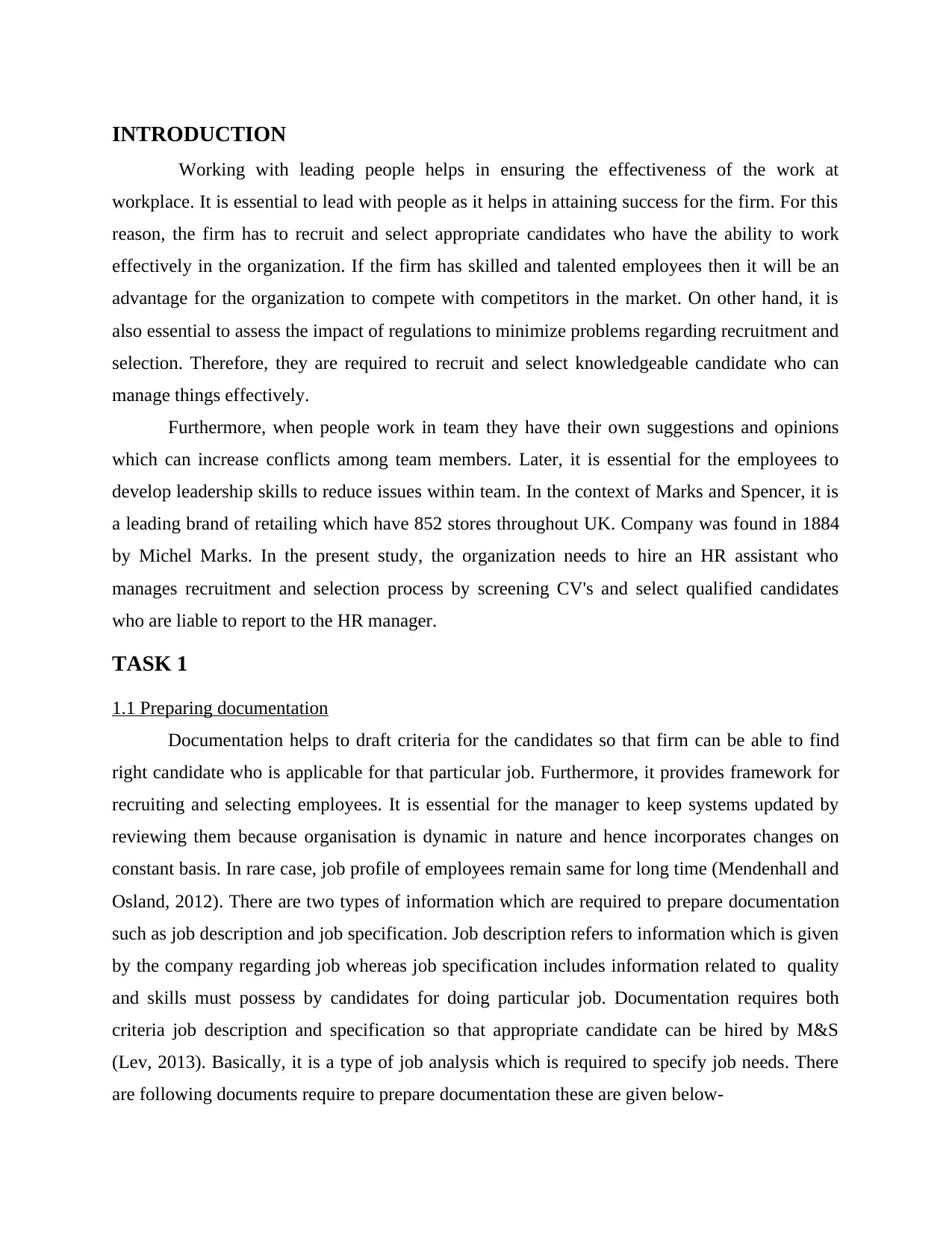
INTRODUCTION
Working with leading people helps in ensuring the effectiveness of the work at
workplace. It is essential to lead with people as it helps in attaining success for the firm. For this
reason, the firm has to recruit and select appropriate candidates who have the ability to work
effectively in the organization. If the firm has skilled and talented employees then it will be an
advantage for the organization to compete with competitors in the market. On other hand, it is
also essential to assess the impact of regulations to minimize problems regarding recruitment and
selection. Therefore, they are required to recruit and select knowledgeable candidate who can
manage things effectively.
Furthermore, when people work in team they have their own suggestions and opinions
which can increase conflicts among team members. Later, it is essential for the employees to
develop leadership skills to reduce issues within team. In the context of Marks and Spencer, it is
a leading brand of retailing which have 852 stores throughout UK. Company was found in 1884
by Michel Marks. In the present study, the organization needs to hire an HR assistant who
manages recruitment and selection process by screening CV's and select qualified candidates
who are liable to report to the HR manager.
TASK 1
1.1 Preparing documentation
Documentation helps to draft criteria for the candidates so that firm can be able to find
right candidate who is applicable for that particular job. Furthermore, it provides framework for
recruiting and selecting employees. It is essential for the manager to keep systems updated by
reviewing them because organisation is dynamic in nature and hence incorporates changes on
constant basis. In rare case, job profile of employees remain same for long time (Mendenhall and
Osland, 2012). There are two types of information which are required to prepare documentation
such as job description and job specification. Job description refers to information which is given
by the company regarding job whereas job specification includes information related to quality
and skills must possess by candidates for doing particular job. Documentation requires both
criteria job description and specification so that appropriate candidate can be hired by M&S
(Lev, 2013). Basically, it is a type of job analysis which is required to specify job needs. There
are following documents require to prepare documentation these are given below-
Working with leading people helps in ensuring the effectiveness of the work at
workplace. It is essential to lead with people as it helps in attaining success for the firm. For this
reason, the firm has to recruit and select appropriate candidates who have the ability to work
effectively in the organization. If the firm has skilled and talented employees then it will be an
advantage for the organization to compete with competitors in the market. On other hand, it is
also essential to assess the impact of regulations to minimize problems regarding recruitment and
selection. Therefore, they are required to recruit and select knowledgeable candidate who can
manage things effectively.
Furthermore, when people work in team they have their own suggestions and opinions
which can increase conflicts among team members. Later, it is essential for the employees to
develop leadership skills to reduce issues within team. In the context of Marks and Spencer, it is
a leading brand of retailing which have 852 stores throughout UK. Company was found in 1884
by Michel Marks. In the present study, the organization needs to hire an HR assistant who
manages recruitment and selection process by screening CV's and select qualified candidates
who are liable to report to the HR manager.
TASK 1
1.1 Preparing documentation
Documentation helps to draft criteria for the candidates so that firm can be able to find
right candidate who is applicable for that particular job. Furthermore, it provides framework for
recruiting and selecting employees. It is essential for the manager to keep systems updated by
reviewing them because organisation is dynamic in nature and hence incorporates changes on
constant basis. In rare case, job profile of employees remain same for long time (Mendenhall and
Osland, 2012). There are two types of information which are required to prepare documentation
such as job description and job specification. Job description refers to information which is given
by the company regarding job whereas job specification includes information related to quality
and skills must possess by candidates for doing particular job. Documentation requires both
criteria job description and specification so that appropriate candidate can be hired by M&S
(Lev, 2013). Basically, it is a type of job analysis which is required to specify job needs. There
are following documents require to prepare documentation these are given below-
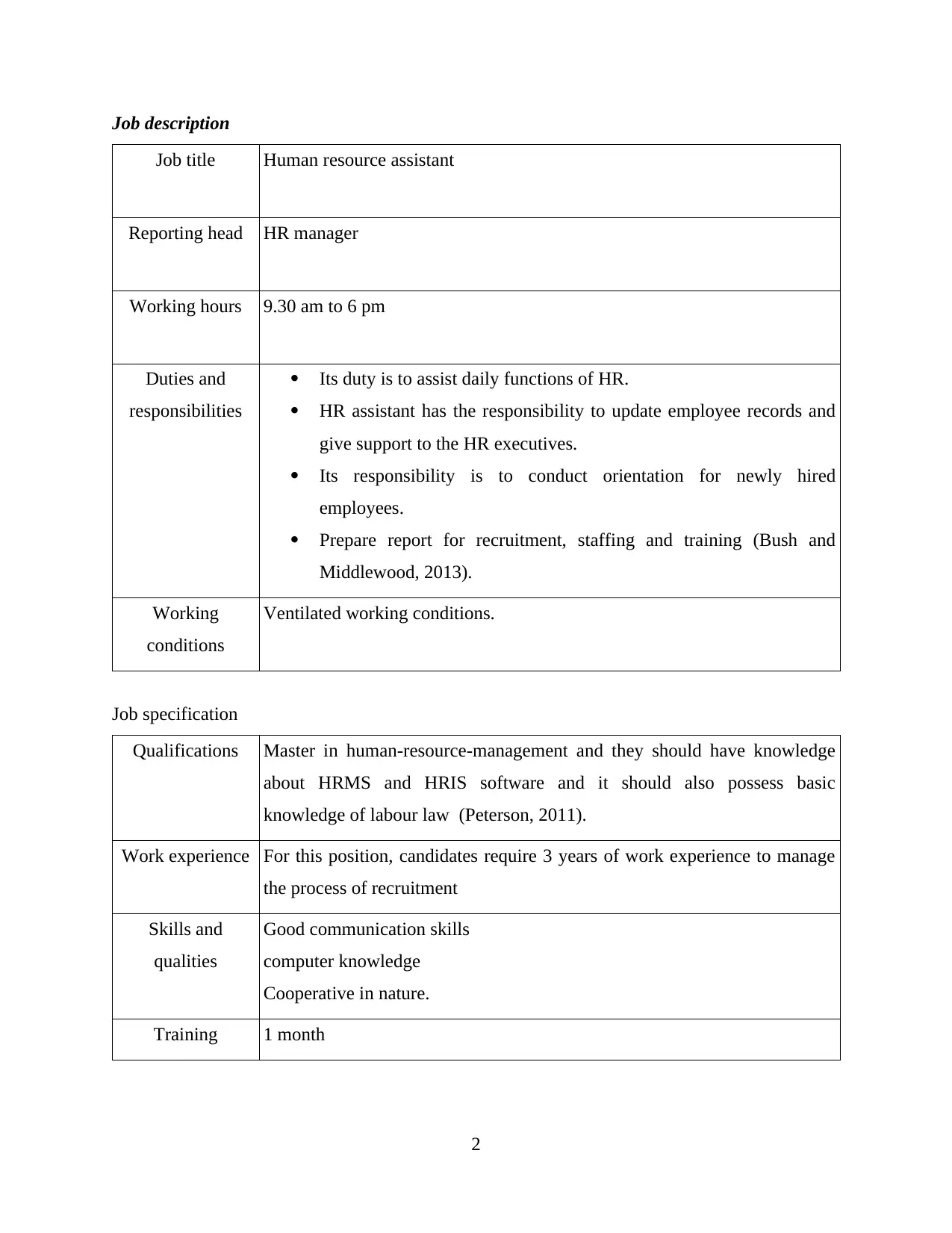
Job description
Job title Human resource assistant
Reporting head HR manager
Working hours 9.30 am to 6 pm
Duties and
responsibilities
Its duty is to assist daily functions of HR.
HR assistant has the responsibility to update employee records and
give support to the HR executives.
Its responsibility is to conduct orientation for newly hired
employees.
Prepare report for recruitment, staffing and training (Bush and
Middlewood, 2013).
Working
conditions
Ventilated working conditions.
Job specification
Qualifications Master in human-resource-management and they should have knowledge
about HRMS and HRIS software and it should also possess basic
knowledge of labour law (Peterson, 2011).
Work experience For this position, candidates require 3 years of work experience to manage
the process of recruitment
Skills and
qualities
Good communication skills
computer knowledge
Cooperative in nature.
Training 1 month
2
Job title Human resource assistant
Reporting head HR manager
Working hours 9.30 am to 6 pm
Duties and
responsibilities
Its duty is to assist daily functions of HR.
HR assistant has the responsibility to update employee records and
give support to the HR executives.
Its responsibility is to conduct orientation for newly hired
employees.
Prepare report for recruitment, staffing and training (Bush and
Middlewood, 2013).
Working
conditions
Ventilated working conditions.
Job specification
Qualifications Master in human-resource-management and they should have knowledge
about HRMS and HRIS software and it should also possess basic
knowledge of labour law (Peterson, 2011).
Work experience For this position, candidates require 3 years of work experience to manage
the process of recruitment
Skills and
qualities
Good communication skills
computer knowledge
Cooperative in nature.
Training 1 month
2
Secure Best Marks with AI Grader
Need help grading? Try our AI Grader for instant feedback on your assignments.
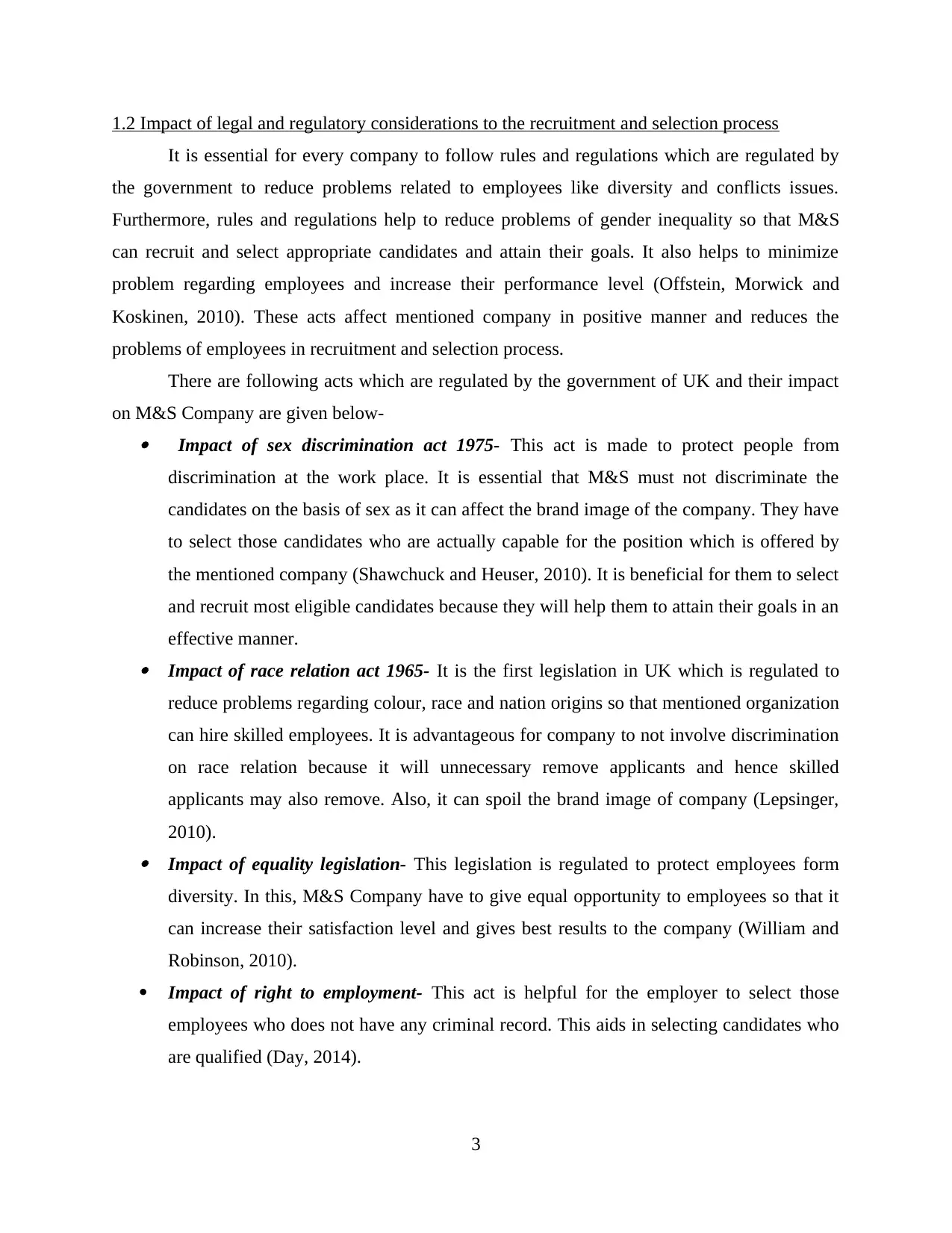
1.2 Impact of legal and regulatory considerations to the recruitment and selection process
It is essential for every company to follow rules and regulations which are regulated by
the government to reduce problems related to employees like diversity and conflicts issues.
Furthermore, rules and regulations help to reduce problems of gender inequality so that M&S
can recruit and select appropriate candidates and attain their goals. It also helps to minimize
problem regarding employees and increase their performance level (Offstein, Morwick and
Koskinen, 2010). These acts affect mentioned company in positive manner and reduces the
problems of employees in recruitment and selection process.
There are following acts which are regulated by the government of UK and their impact
on M&S Company are given below- Impact of sex discrimination act 1975- This act is made to protect people from
discrimination at the work place. It is essential that M&S must not discriminate the
candidates on the basis of sex as it can affect the brand image of the company. They have
to select those candidates who are actually capable for the position which is offered by
the mentioned company (Shawchuck and Heuser, 2010). It is beneficial for them to select
and recruit most eligible candidates because they will help them to attain their goals in an
effective manner. Impact of race relation act 1965- It is the first legislation in UK which is regulated to
reduce problems regarding colour, race and nation origins so that mentioned organization
can hire skilled employees. It is advantageous for company to not involve discrimination
on race relation because it will unnecessary remove applicants and hence skilled
applicants may also remove. Also, it can spoil the brand image of company (Lepsinger,
2010). Impact of equality legislation- This legislation is regulated to protect employees form
diversity. In this, M&S Company have to give equal opportunity to employees so that it
can increase their satisfaction level and gives best results to the company (William and
Robinson, 2010).
Impact of right to employment- This act is helpful for the employer to select those
employees who does not have any criminal record. This aids in selecting candidates who
are qualified (Day, 2014).
3
It is essential for every company to follow rules and regulations which are regulated by
the government to reduce problems related to employees like diversity and conflicts issues.
Furthermore, rules and regulations help to reduce problems of gender inequality so that M&S
can recruit and select appropriate candidates and attain their goals. It also helps to minimize
problem regarding employees and increase their performance level (Offstein, Morwick and
Koskinen, 2010). These acts affect mentioned company in positive manner and reduces the
problems of employees in recruitment and selection process.
There are following acts which are regulated by the government of UK and their impact
on M&S Company are given below- Impact of sex discrimination act 1975- This act is made to protect people from
discrimination at the work place. It is essential that M&S must not discriminate the
candidates on the basis of sex as it can affect the brand image of the company. They have
to select those candidates who are actually capable for the position which is offered by
the mentioned company (Shawchuck and Heuser, 2010). It is beneficial for them to select
and recruit most eligible candidates because they will help them to attain their goals in an
effective manner. Impact of race relation act 1965- It is the first legislation in UK which is regulated to
reduce problems regarding colour, race and nation origins so that mentioned organization
can hire skilled employees. It is advantageous for company to not involve discrimination
on race relation because it will unnecessary remove applicants and hence skilled
applicants may also remove. Also, it can spoil the brand image of company (Lepsinger,
2010). Impact of equality legislation- This legislation is regulated to protect employees form
diversity. In this, M&S Company have to give equal opportunity to employees so that it
can increase their satisfaction level and gives best results to the company (William and
Robinson, 2010).
Impact of right to employment- This act is helpful for the employer to select those
employees who does not have any criminal record. This aids in selecting candidates who
are qualified (Day, 2014).
3
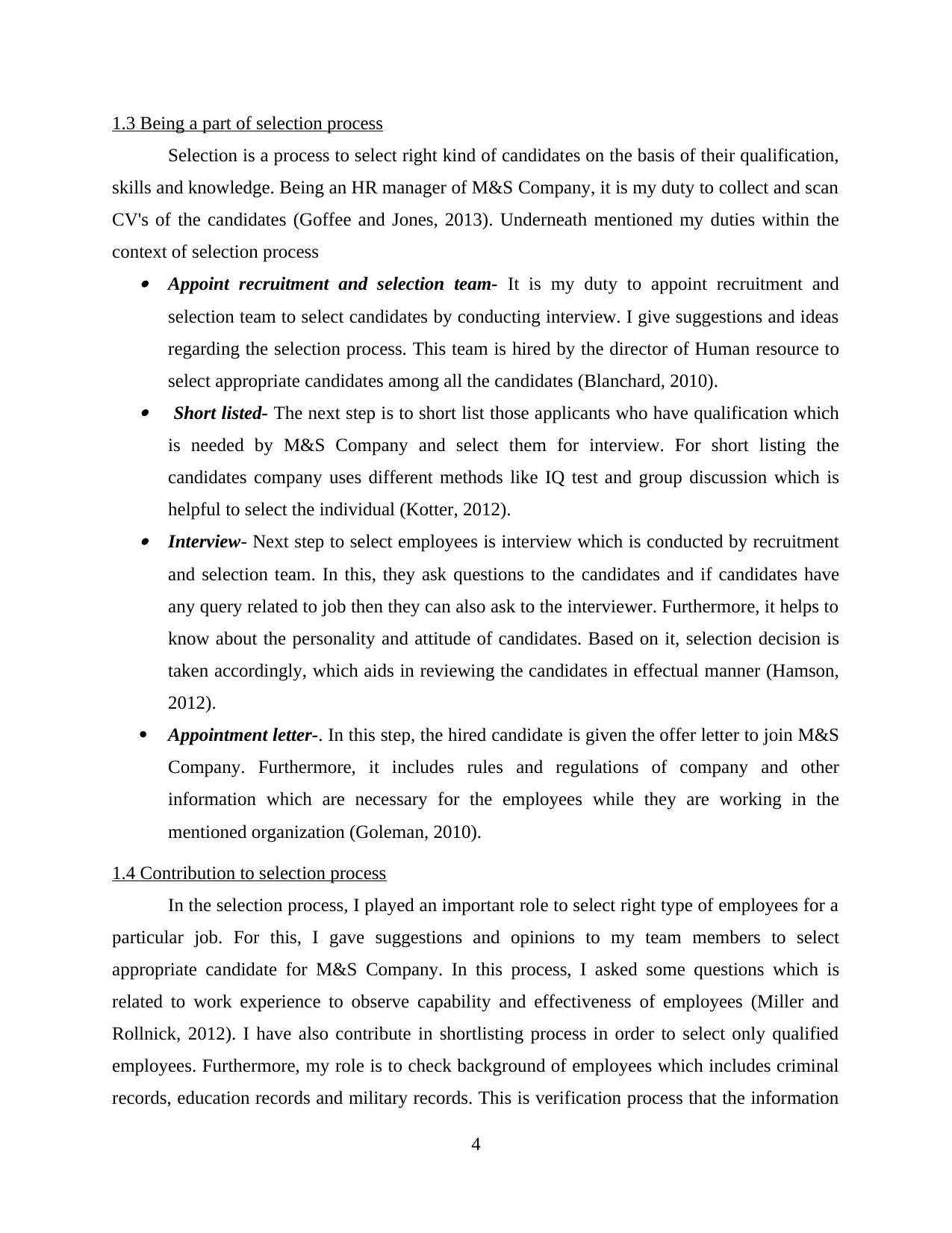
1.3 Being a part of selection process
Selection is a process to select right kind of candidates on the basis of their qualification,
skills and knowledge. Being an HR manager of M&S Company, it is my duty to collect and scan
CV's of the candidates (Goffee and Jones, 2013). Underneath mentioned my duties within the
context of selection process Appoint recruitment and selection team- It is my duty to appoint recruitment and
selection team to select candidates by conducting interview. I give suggestions and ideas
regarding the selection process. This team is hired by the director of Human resource to
select appropriate candidates among all the candidates (Blanchard, 2010). Short listed- The next step is to short list those applicants who have qualification which
is needed by M&S Company and select them for interview. For short listing the
candidates company uses different methods like IQ test and group discussion which is
helpful to select the individual (Kotter, 2012). Interview- Next step to select employees is interview which is conducted by recruitment
and selection team. In this, they ask questions to the candidates and if candidates have
any query related to job then they can also ask to the interviewer. Furthermore, it helps to
know about the personality and attitude of candidates. Based on it, selection decision is
taken accordingly, which aids in reviewing the candidates in effectual manner (Hamson,
2012).
Appointment letter-. In this step, the hired candidate is given the offer letter to join M&S
Company. Furthermore, it includes rules and regulations of company and other
information which are necessary for the employees while they are working in the
mentioned organization (Goleman, 2010).
1.4 Contribution to selection process
In the selection process, I played an important role to select right type of employees for a
particular job. For this, I gave suggestions and opinions to my team members to select
appropriate candidate for M&S Company. In this process, I asked some questions which is
related to work experience to observe capability and effectiveness of employees (Miller and
Rollnick, 2012). I have also contribute in shortlisting process in order to select only qualified
employees. Furthermore, my role is to check background of employees which includes criminal
records, education records and military records. This is verification process that the information
4
Selection is a process to select right kind of candidates on the basis of their qualification,
skills and knowledge. Being an HR manager of M&S Company, it is my duty to collect and scan
CV's of the candidates (Goffee and Jones, 2013). Underneath mentioned my duties within the
context of selection process Appoint recruitment and selection team- It is my duty to appoint recruitment and
selection team to select candidates by conducting interview. I give suggestions and ideas
regarding the selection process. This team is hired by the director of Human resource to
select appropriate candidates among all the candidates (Blanchard, 2010). Short listed- The next step is to short list those applicants who have qualification which
is needed by M&S Company and select them for interview. For short listing the
candidates company uses different methods like IQ test and group discussion which is
helpful to select the individual (Kotter, 2012). Interview- Next step to select employees is interview which is conducted by recruitment
and selection team. In this, they ask questions to the candidates and if candidates have
any query related to job then they can also ask to the interviewer. Furthermore, it helps to
know about the personality and attitude of candidates. Based on it, selection decision is
taken accordingly, which aids in reviewing the candidates in effectual manner (Hamson,
2012).
Appointment letter-. In this step, the hired candidate is given the offer letter to join M&S
Company. Furthermore, it includes rules and regulations of company and other
information which are necessary for the employees while they are working in the
mentioned organization (Goleman, 2010).
1.4 Contribution to selection process
In the selection process, I played an important role to select right type of employees for a
particular job. For this, I gave suggestions and opinions to my team members to select
appropriate candidate for M&S Company. In this process, I asked some questions which is
related to work experience to observe capability and effectiveness of employees (Miller and
Rollnick, 2012). I have also contribute in shortlisting process in order to select only qualified
employees. Furthermore, my role is to check background of employees which includes criminal
records, education records and military records. This is verification process that the information
4

which is provided by candidates is correct or not. If the candidate passes the verification test then
it is hired for the profile (Kuroda, Yuki and Kang, 2010).
Another contribution which is given by me is to ensure that right candidate is selected
with the help of interview section. After this, I give the list of finalized candidates for the last
interview which is conducted by the director of Human resource of M&S Company. In this
process I gave my views and opinions to candidates to measure their skills and knowledge level
(Gwyer, 2010). My contribution in the recruiting process is that I give information about the
company which is required for them so that they can easily outline the job profile. Furthermore, I
suggest the team to hire candidates who have knowledge of software which is used by the
company such as HRMS and HRIS. Due to this, team members ask questions related to the
software (McKimm, 2011).
These types of software are used by the company to maintain the information of employees.
For that, the team members take technical test to know about experience of the software. It is
most important for every team members that they does not select candidates on the basis of
personal relationships rather they select the one who actually deserve the job (Offstein and
Morwick, 2011).
TASK 2
2.1 Explaining skills and attributes required for leadership
Leadership refers to the ability which is required to lead within team and to provide
guidance and directions so that desired goals can be achieved. It is important to use appropriate
leadership style so that team member feels motivated as this will help in increasing the
performance level. It is essential for M&S Company to use leadership styles and for that the
company have to recruit and select skilled and knowledgeable employees so that they can
achieve goals of the company (Arroba and et.al. 2011.). An appropriate leadership requires
qualities and abilities to lead a team. These are following skills and attributes which should be
possessed by the leader and they are as follows- Effective communication skills- A good leader needs to have effective communication
skill so that they communicate effectively with the team members. It can affects overall
environment of M&S, if they will not able to communicate effectively it will increase
conflicts among team members. Therefore, it is important to have effective
communication skills (Whitney, Trosten-Bloom and Rader, 2010).
5
it is hired for the profile (Kuroda, Yuki and Kang, 2010).
Another contribution which is given by me is to ensure that right candidate is selected
with the help of interview section. After this, I give the list of finalized candidates for the last
interview which is conducted by the director of Human resource of M&S Company. In this
process I gave my views and opinions to candidates to measure their skills and knowledge level
(Gwyer, 2010). My contribution in the recruiting process is that I give information about the
company which is required for them so that they can easily outline the job profile. Furthermore, I
suggest the team to hire candidates who have knowledge of software which is used by the
company such as HRMS and HRIS. Due to this, team members ask questions related to the
software (McKimm, 2011).
These types of software are used by the company to maintain the information of employees.
For that, the team members take technical test to know about experience of the software. It is
most important for every team members that they does not select candidates on the basis of
personal relationships rather they select the one who actually deserve the job (Offstein and
Morwick, 2011).
TASK 2
2.1 Explaining skills and attributes required for leadership
Leadership refers to the ability which is required to lead within team and to provide
guidance and directions so that desired goals can be achieved. It is important to use appropriate
leadership style so that team member feels motivated as this will help in increasing the
performance level. It is essential for M&S Company to use leadership styles and for that the
company have to recruit and select skilled and knowledgeable employees so that they can
achieve goals of the company (Arroba and et.al. 2011.). An appropriate leadership requires
qualities and abilities to lead a team. These are following skills and attributes which should be
possessed by the leader and they are as follows- Effective communication skills- A good leader needs to have effective communication
skill so that they communicate effectively with the team members. It can affects overall
environment of M&S, if they will not able to communicate effectively it will increase
conflicts among team members. Therefore, it is important to have effective
communication skills (Whitney, Trosten-Bloom and Rader, 2010).
5
Paraphrase This Document
Need a fresh take? Get an instant paraphrase of this document with our AI Paraphraser

Problem solving- A good leader should have the ability to solve problems of team
members so that they can attain goals of the company. If team members have problems
regarding their task then it is the duty of the leader to solve them by providing
alternatives of the solution (Fraley and et.al. 2011). Motivation- It is an effective ability which is required by every leader so that they can
motivate their employees for better performance. Furthermore, motivation helps the
employees to increase their satisfaction to attain goals of M&S Company. Team working skills- Good leaders have team working skills which help the members to
work effectively by coordinating with each other. Furthermore, leader has to build
relationship among employees so that they can give ideas, suggestions and views to
accomplish goals (McSherry and Warr, 2010).
Emotional intelligence- It refers to the capacity to understand others emotions to reduce
the chances of discrimination of feelings. Further, it is an ability of a leader to understand
their team member’s feelings and use the information to guide them.
2.2 Difference between leadership and management
Leadership and management is an important part of every firm because all functions and
directions are depend on these two aspects only. Leadership is an important tool to direct and
guide team members and management is functionary part of the firm. In other words, leadership
refers to the ability to lead a team and achieve goals of the company whereas management refers
to the functions of the firm which include planning, organising and controlling (Pritchard and
Bloomfield, 2013).
Leadership focuses on accomplishing goal of the company where management focuses
on the allotted tasks of M&S. Moreover, it is important for the team to have leaders who direct,
motivate and utilize their team member’s skills to attain goals of the organization. On other hand,
leaders take risk to attain the objectives whereas managers are risk averse in nature (Stanleigh,
2013). Leaders create more conducive environment to get success by focusing on vision of M&S
Company whereas management focuses on resources such as human, time, money and
equipment of the for attaining their objectives (Kouzes and Posner, 2011).
Furthermore, leaders have the right to take decision of their team whereas managers take
decision for the firm. Leaders are teachers and mentors for team members which provide
knowledge and information about task whereas managers direct employees to achieve goals of
6
members so that they can attain goals of the company. If team members have problems
regarding their task then it is the duty of the leader to solve them by providing
alternatives of the solution (Fraley and et.al. 2011). Motivation- It is an effective ability which is required by every leader so that they can
motivate their employees for better performance. Furthermore, motivation helps the
employees to increase their satisfaction to attain goals of M&S Company. Team working skills- Good leaders have team working skills which help the members to
work effectively by coordinating with each other. Furthermore, leader has to build
relationship among employees so that they can give ideas, suggestions and views to
accomplish goals (McSherry and Warr, 2010).
Emotional intelligence- It refers to the capacity to understand others emotions to reduce
the chances of discrimination of feelings. Further, it is an ability of a leader to understand
their team member’s feelings and use the information to guide them.
2.2 Difference between leadership and management
Leadership and management is an important part of every firm because all functions and
directions are depend on these two aspects only. Leadership is an important tool to direct and
guide team members and management is functionary part of the firm. In other words, leadership
refers to the ability to lead a team and achieve goals of the company whereas management refers
to the functions of the firm which include planning, organising and controlling (Pritchard and
Bloomfield, 2013).
Leadership focuses on accomplishing goal of the company where management focuses
on the allotted tasks of M&S. Moreover, it is important for the team to have leaders who direct,
motivate and utilize their team member’s skills to attain goals of the organization. On other hand,
leaders take risk to attain the objectives whereas managers are risk averse in nature (Stanleigh,
2013). Leaders create more conducive environment to get success by focusing on vision of M&S
Company whereas management focuses on resources such as human, time, money and
equipment of the for attaining their objectives (Kouzes and Posner, 2011).
Furthermore, leaders have the right to take decision of their team whereas managers take
decision for the firm. Leaders are teachers and mentors for team members which provide
knowledge and information about task whereas managers direct employees to achieve goals of
6
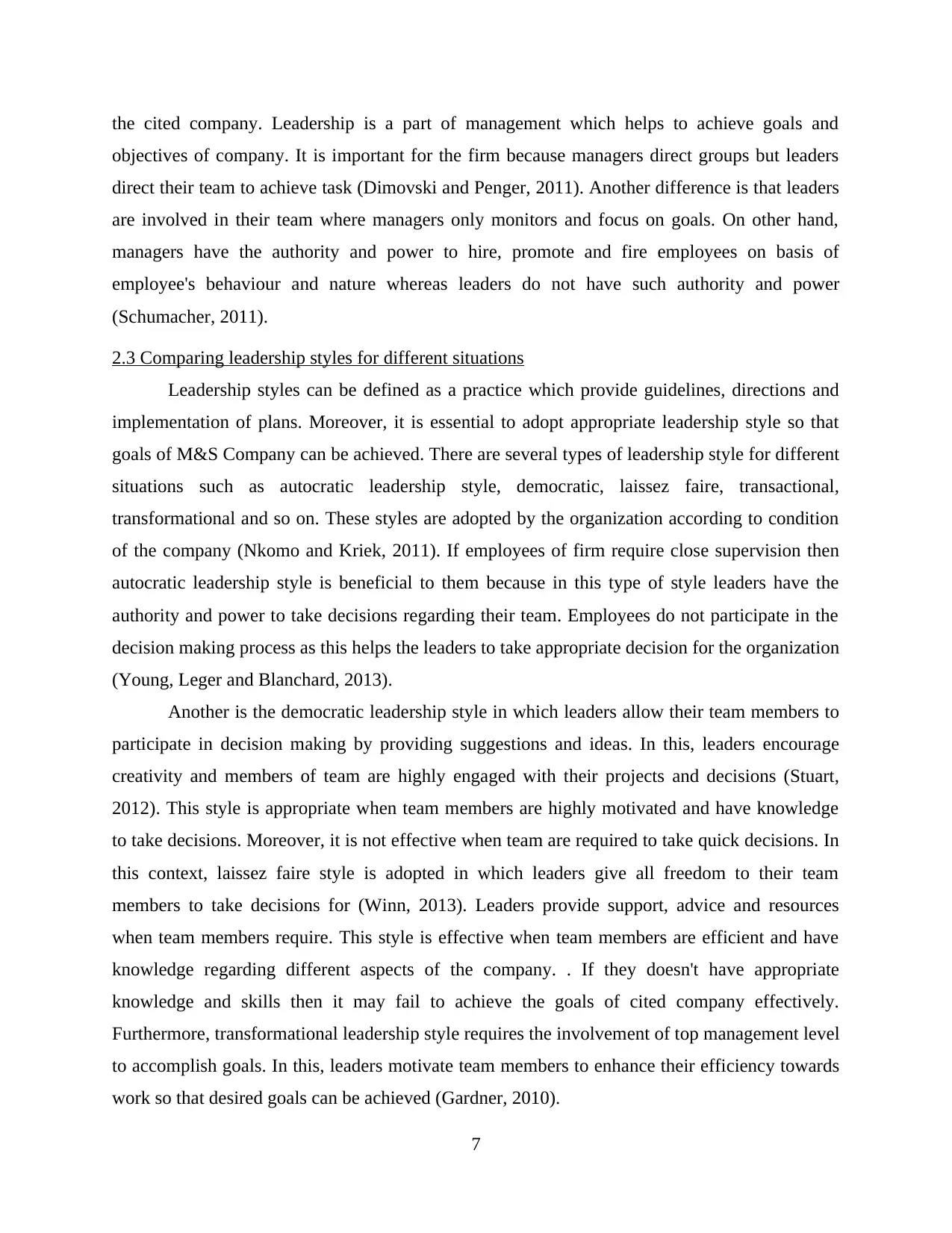
the cited company. Leadership is a part of management which helps to achieve goals and
objectives of company. It is important for the firm because managers direct groups but leaders
direct their team to achieve task (Dimovski and Penger, 2011). Another difference is that leaders
are involved in their team where managers only monitors and focus on goals. On other hand,
managers have the authority and power to hire, promote and fire employees on basis of
employee's behaviour and nature whereas leaders do not have such authority and power
(Schumacher, 2011).
2.3 Comparing leadership styles for different situations
Leadership styles can be defined as a practice which provide guidelines, directions and
implementation of plans. Moreover, it is essential to adopt appropriate leadership style so that
goals of M&S Company can be achieved. There are several types of leadership style for different
situations such as autocratic leadership style, democratic, laissez faire, transactional,
transformational and so on. These styles are adopted by the organization according to condition
of the company (Nkomo and Kriek, 2011). If employees of firm require close supervision then
autocratic leadership style is beneficial to them because in this type of style leaders have the
authority and power to take decisions regarding their team. Employees do not participate in the
decision making process as this helps the leaders to take appropriate decision for the organization
(Young, Leger and Blanchard, 2013).
Another is the democratic leadership style in which leaders allow their team members to
participate in decision making by providing suggestions and ideas. In this, leaders encourage
creativity and members of team are highly engaged with their projects and decisions (Stuart,
2012). This style is appropriate when team members are highly motivated and have knowledge
to take decisions. Moreover, it is not effective when team are required to take quick decisions. In
this context, laissez faire style is adopted in which leaders give all freedom to their team
members to take decisions for (Winn, 2013). Leaders provide support, advice and resources
when team members require. This style is effective when team members are efficient and have
knowledge regarding different aspects of the company. . If they doesn't have appropriate
knowledge and skills then it may fail to achieve the goals of cited company effectively.
Furthermore, transformational leadership style requires the involvement of top management level
to accomplish goals. In this, leaders motivate team members to enhance their efficiency towards
work so that desired goals can be achieved (Gardner, 2010).
7
objectives of company. It is important for the firm because managers direct groups but leaders
direct their team to achieve task (Dimovski and Penger, 2011). Another difference is that leaders
are involved in their team where managers only monitors and focus on goals. On other hand,
managers have the authority and power to hire, promote and fire employees on basis of
employee's behaviour and nature whereas leaders do not have such authority and power
(Schumacher, 2011).
2.3 Comparing leadership styles for different situations
Leadership styles can be defined as a practice which provide guidelines, directions and
implementation of plans. Moreover, it is essential to adopt appropriate leadership style so that
goals of M&S Company can be achieved. There are several types of leadership style for different
situations such as autocratic leadership style, democratic, laissez faire, transactional,
transformational and so on. These styles are adopted by the organization according to condition
of the company (Nkomo and Kriek, 2011). If employees of firm require close supervision then
autocratic leadership style is beneficial to them because in this type of style leaders have the
authority and power to take decisions regarding their team. Employees do not participate in the
decision making process as this helps the leaders to take appropriate decision for the organization
(Young, Leger and Blanchard, 2013).
Another is the democratic leadership style in which leaders allow their team members to
participate in decision making by providing suggestions and ideas. In this, leaders encourage
creativity and members of team are highly engaged with their projects and decisions (Stuart,
2012). This style is appropriate when team members are highly motivated and have knowledge
to take decisions. Moreover, it is not effective when team are required to take quick decisions. In
this context, laissez faire style is adopted in which leaders give all freedom to their team
members to take decisions for (Winn, 2013). Leaders provide support, advice and resources
when team members require. This style is effective when team members are efficient and have
knowledge regarding different aspects of the company. . If they doesn't have appropriate
knowledge and skills then it may fail to achieve the goals of cited company effectively.
Furthermore, transformational leadership style requires the involvement of top management level
to accomplish goals. In this, leaders motivate team members to enhance their efficiency towards
work so that desired goals can be achieved (Gardner, 2010).
7
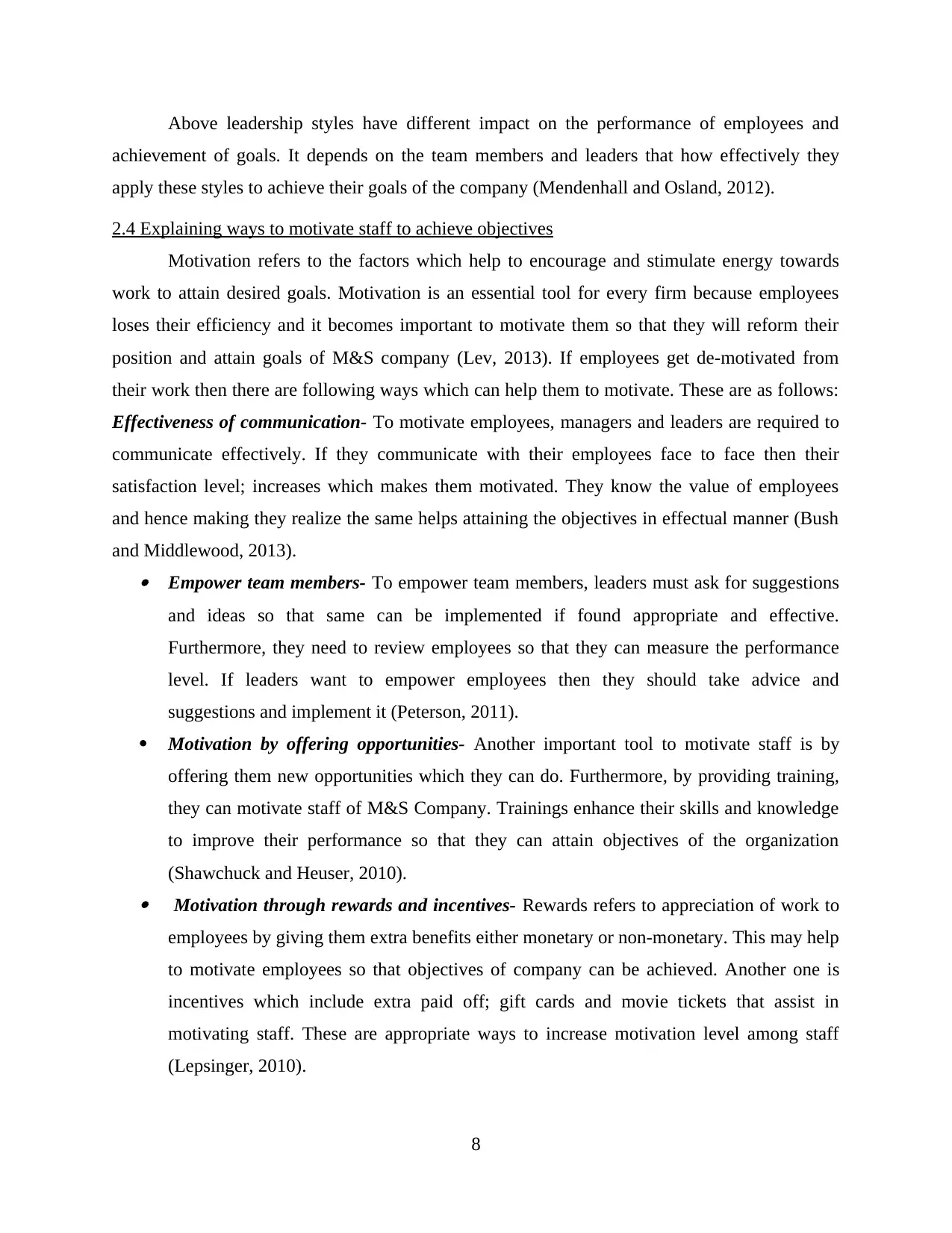
Above leadership styles have different impact on the performance of employees and
achievement of goals. It depends on the team members and leaders that how effectively they
apply these styles to achieve their goals of the company (Mendenhall and Osland, 2012).
2.4 Explaining ways to motivate staff to achieve objectives
Motivation refers to the factors which help to encourage and stimulate energy towards
work to attain desired goals. Motivation is an essential tool for every firm because employees
loses their efficiency and it becomes important to motivate them so that they will reform their
position and attain goals of M&S company (Lev, 2013). If employees get de-motivated from
their work then there are following ways which can help them to motivate. These are as follows:
Effectiveness of communication- To motivate employees, managers and leaders are required to
communicate effectively. If they communicate with their employees face to face then their
satisfaction level; increases which makes them motivated. They know the value of employees
and hence making they realize the same helps attaining the objectives in effectual manner (Bush
and Middlewood, 2013). Empower team members- To empower team members, leaders must ask for suggestions
and ideas so that same can be implemented if found appropriate and effective.
Furthermore, they need to review employees so that they can measure the performance
level. If leaders want to empower employees then they should take advice and
suggestions and implement it (Peterson, 2011).
Motivation by offering opportunities- Another important tool to motivate staff is by
offering them new opportunities which they can do. Furthermore, by providing training,
they can motivate staff of M&S Company. Trainings enhance their skills and knowledge
to improve their performance so that they can attain objectives of the organization
(Shawchuck and Heuser, 2010). Motivation through rewards and incentives- Rewards refers to appreciation of work to
employees by giving them extra benefits either monetary or non-monetary. This may help
to motivate employees so that objectives of company can be achieved. Another one is
incentives which include extra paid off; gift cards and movie tickets that assist in
motivating staff. These are appropriate ways to increase motivation level among staff
(Lepsinger, 2010).
8
achievement of goals. It depends on the team members and leaders that how effectively they
apply these styles to achieve their goals of the company (Mendenhall and Osland, 2012).
2.4 Explaining ways to motivate staff to achieve objectives
Motivation refers to the factors which help to encourage and stimulate energy towards
work to attain desired goals. Motivation is an essential tool for every firm because employees
loses their efficiency and it becomes important to motivate them so that they will reform their
position and attain goals of M&S company (Lev, 2013). If employees get de-motivated from
their work then there are following ways which can help them to motivate. These are as follows:
Effectiveness of communication- To motivate employees, managers and leaders are required to
communicate effectively. If they communicate with their employees face to face then their
satisfaction level; increases which makes them motivated. They know the value of employees
and hence making they realize the same helps attaining the objectives in effectual manner (Bush
and Middlewood, 2013). Empower team members- To empower team members, leaders must ask for suggestions
and ideas so that same can be implemented if found appropriate and effective.
Furthermore, they need to review employees so that they can measure the performance
level. If leaders want to empower employees then they should take advice and
suggestions and implement it (Peterson, 2011).
Motivation by offering opportunities- Another important tool to motivate staff is by
offering them new opportunities which they can do. Furthermore, by providing training,
they can motivate staff of M&S Company. Trainings enhance their skills and knowledge
to improve their performance so that they can attain objectives of the organization
(Shawchuck and Heuser, 2010). Motivation through rewards and incentives- Rewards refers to appreciation of work to
employees by giving them extra benefits either monetary or non-monetary. This may help
to motivate employees so that objectives of company can be achieved. Another one is
incentives which include extra paid off; gift cards and movie tickets that assist in
motivating staff. These are appropriate ways to increase motivation level among staff
(Lepsinger, 2010).
8
Secure Best Marks with AI Grader
Need help grading? Try our AI Grader for instant feedback on your assignments.

Motivation through feedback- Another tool which is effective to motivate staff is
feedback. In this, mangers should receive feedback of staff and introduce changes
accordingly so that they can feel motivated and attain objectives of the company
(William, 2010).
TASK 3
3.1 Assessing benefits of team working
Team work refers to the process of working in a group or team for accomplishing goals
of the firm. It is essential for every firm to work in a team so that they can share ideas, views and
suggestions with each other. Furthermore, it is done by coordination and cooperation with team
members to complete task and attain goals of company (Day, 2014). There are following benefits
of team working which are given below- Increase creativity- A team is a group of different people who have diverse thoughts and
ideas. This is helpful for the team to create something new which is beneficial for the
company. Moreover, it increases creativity of employees by enhancing their satisfaction
level (Goffee and Jones, 2013). Maximize involvement- Teamwork maximizes involvement of team members to perform
task. In this, employees utilize their skills and knowledge to achieve goals effectively. Reduce complications and difficulties- Working with coordination helps in reducing
problems and difficulties regarding task. Furthermore, if any of team members has
difficulty in task then the other members can help to solve problems. Therefore, it is
beneficial in reducing complications which mostly arises at the workplace (Blanchard,
2010). Increase motivation and morale- It is a major benefit of team work that members can
motivate each other towards work. Through this, they can able to maintain their high
performance within team. Moreover, it also increases morale of employees by motivating
them (Kotter, 2012). Reduce work load- Team work also helps to employees to reduce over burden of work.
In this, team members segregate their work and share task with each other so that they
can attain objectives and goals effectively. Furthermore, it helps to reduce pressure of
work so that employees utilize their skills in an efficient way (Hamson, 2012).
9
feedback. In this, mangers should receive feedback of staff and introduce changes
accordingly so that they can feel motivated and attain objectives of the company
(William, 2010).
TASK 3
3.1 Assessing benefits of team working
Team work refers to the process of working in a group or team for accomplishing goals
of the firm. It is essential for every firm to work in a team so that they can share ideas, views and
suggestions with each other. Furthermore, it is done by coordination and cooperation with team
members to complete task and attain goals of company (Day, 2014). There are following benefits
of team working which are given below- Increase creativity- A team is a group of different people who have diverse thoughts and
ideas. This is helpful for the team to create something new which is beneficial for the
company. Moreover, it increases creativity of employees by enhancing their satisfaction
level (Goffee and Jones, 2013). Maximize involvement- Teamwork maximizes involvement of team members to perform
task. In this, employees utilize their skills and knowledge to achieve goals effectively. Reduce complications and difficulties- Working with coordination helps in reducing
problems and difficulties regarding task. Furthermore, if any of team members has
difficulty in task then the other members can help to solve problems. Therefore, it is
beneficial in reducing complications which mostly arises at the workplace (Blanchard,
2010). Increase motivation and morale- It is a major benefit of team work that members can
motivate each other towards work. Through this, they can able to maintain their high
performance within team. Moreover, it also increases morale of employees by motivating
them (Kotter, 2012). Reduce work load- Team work also helps to employees to reduce over burden of work.
In this, team members segregate their work and share task with each other so that they
can attain objectives and goals effectively. Furthermore, it helps to reduce pressure of
work so that employees utilize their skills in an efficient way (Hamson, 2012).
9
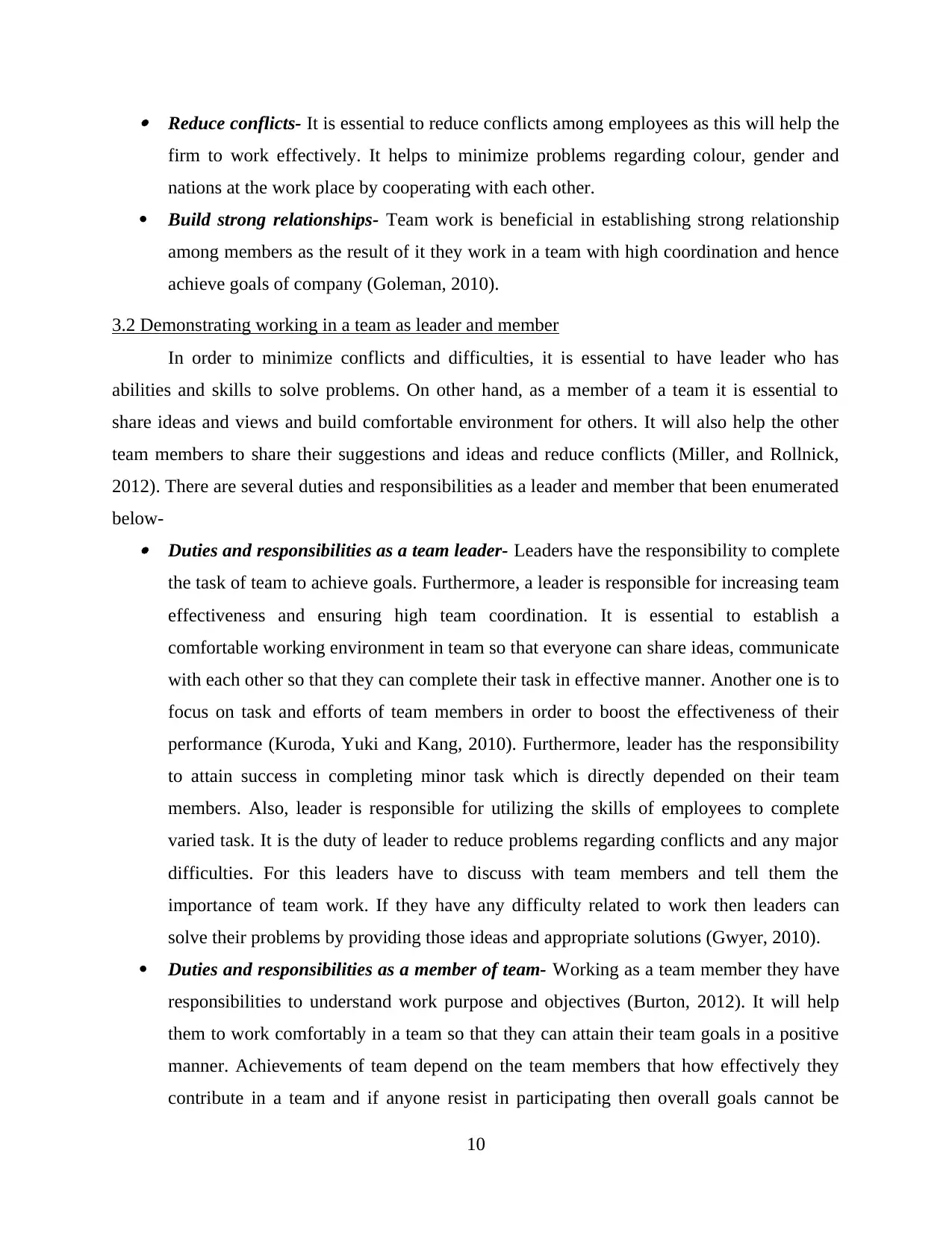
Reduce conflicts- It is essential to reduce conflicts among employees as this will help the
firm to work effectively. It helps to minimize problems regarding colour, gender and
nations at the work place by cooperating with each other.
Build strong relationships- Team work is beneficial in establishing strong relationship
among members as the result of it they work in a team with high coordination and hence
achieve goals of company (Goleman, 2010).
3.2 Demonstrating working in a team as leader and member
In order to minimize conflicts and difficulties, it is essential to have leader who has
abilities and skills to solve problems. On other hand, as a member of a team it is essential to
share ideas and views and build comfortable environment for others. It will also help the other
team members to share their suggestions and ideas and reduce conflicts (Miller, and Rollnick,
2012). There are several duties and responsibilities as a leader and member that been enumerated
below- Duties and responsibilities as a team leader- Leaders have the responsibility to complete
the task of team to achieve goals. Furthermore, a leader is responsible for increasing team
effectiveness and ensuring high team coordination. It is essential to establish a
comfortable working environment in team so that everyone can share ideas, communicate
with each other so that they can complete their task in effective manner. Another one is to
focus on task and efforts of team members in order to boost the effectiveness of their
performance (Kuroda, Yuki and Kang, 2010). Furthermore, leader has the responsibility
to attain success in completing minor task which is directly depended on their team
members. Also, leader is responsible for utilizing the skills of employees to complete
varied task. It is the duty of leader to reduce problems regarding conflicts and any major
difficulties. For this leaders have to discuss with team members and tell them the
importance of team work. If they have any difficulty related to work then leaders can
solve their problems by providing those ideas and appropriate solutions (Gwyer, 2010).
Duties and responsibilities as a member of team- Working as a team member they have
responsibilities to understand work purpose and objectives (Burton, 2012). It will help
them to work comfortably in a team so that they can attain their team goals in a positive
manner. Achievements of team depend on the team members that how effectively they
contribute in a team and if anyone resist in participating then overall goals cannot be
10
firm to work effectively. It helps to minimize problems regarding colour, gender and
nations at the work place by cooperating with each other.
Build strong relationships- Team work is beneficial in establishing strong relationship
among members as the result of it they work in a team with high coordination and hence
achieve goals of company (Goleman, 2010).
3.2 Demonstrating working in a team as leader and member
In order to minimize conflicts and difficulties, it is essential to have leader who has
abilities and skills to solve problems. On other hand, as a member of a team it is essential to
share ideas and views and build comfortable environment for others. It will also help the other
team members to share their suggestions and ideas and reduce conflicts (Miller, and Rollnick,
2012). There are several duties and responsibilities as a leader and member that been enumerated
below- Duties and responsibilities as a team leader- Leaders have the responsibility to complete
the task of team to achieve goals. Furthermore, a leader is responsible for increasing team
effectiveness and ensuring high team coordination. It is essential to establish a
comfortable working environment in team so that everyone can share ideas, communicate
with each other so that they can complete their task in effective manner. Another one is to
focus on task and efforts of team members in order to boost the effectiveness of their
performance (Kuroda, Yuki and Kang, 2010). Furthermore, leader has the responsibility
to attain success in completing minor task which is directly depended on their team
members. Also, leader is responsible for utilizing the skills of employees to complete
varied task. It is the duty of leader to reduce problems regarding conflicts and any major
difficulties. For this leaders have to discuss with team members and tell them the
importance of team work. If they have any difficulty related to work then leaders can
solve their problems by providing those ideas and appropriate solutions (Gwyer, 2010).
Duties and responsibilities as a member of team- Working as a team member they have
responsibilities to understand work purpose and objectives (Burton, 2012). It will help
them to work comfortably in a team so that they can attain their team goals in a positive
manner. Achievements of team depend on the team members that how effectively they
contribute in a team and if anyone resist in participating then overall goals cannot be
10
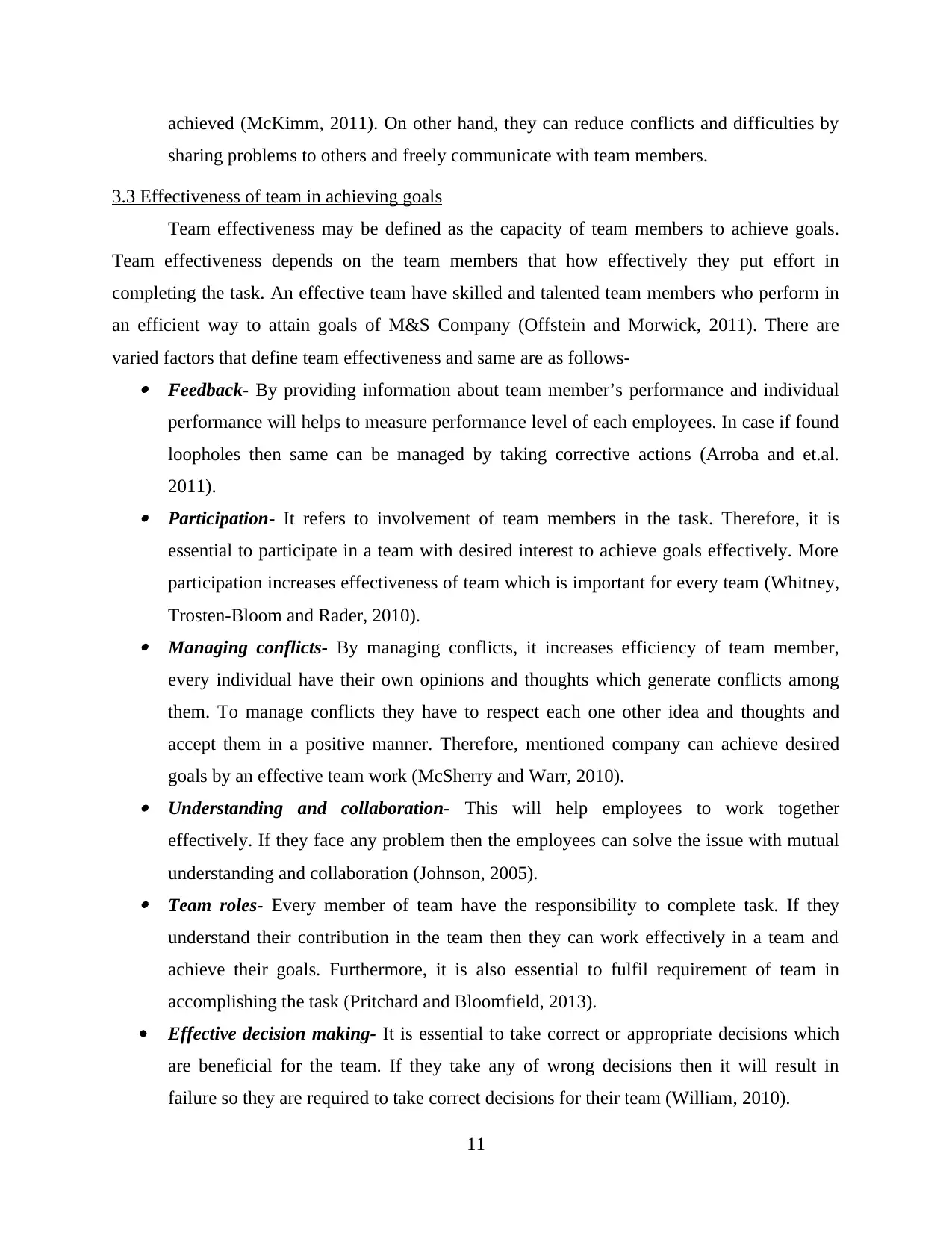
achieved (McKimm, 2011). On other hand, they can reduce conflicts and difficulties by
sharing problems to others and freely communicate with team members.
3.3 Effectiveness of team in achieving goals
Team effectiveness may be defined as the capacity of team members to achieve goals.
Team effectiveness depends on the team members that how effectively they put effort in
completing the task. An effective team have skilled and talented team members who perform in
an efficient way to attain goals of M&S Company (Offstein and Morwick, 2011). There are
varied factors that define team effectiveness and same are as follows- Feedback- By providing information about team member’s performance and individual
performance will helps to measure performance level of each employees. In case if found
loopholes then same can be managed by taking corrective actions (Arroba and et.al.
2011). Participation- It refers to involvement of team members in the task. Therefore, it is
essential to participate in a team with desired interest to achieve goals effectively. More
participation increases effectiveness of team which is important for every team (Whitney,
Trosten-Bloom and Rader, 2010). Managing conflicts- By managing conflicts, it increases efficiency of team member,
every individual have their own opinions and thoughts which generate conflicts among
them. To manage conflicts they have to respect each one other idea and thoughts and
accept them in a positive manner. Therefore, mentioned company can achieve desired
goals by an effective team work (McSherry and Warr, 2010). Understanding and collaboration- This will help employees to work together
effectively. If they face any problem then the employees can solve the issue with mutual
understanding and collaboration (Johnson, 2005). Team roles- Every member of team have the responsibility to complete task. If they
understand their contribution in the team then they can work effectively in a team and
achieve their goals. Furthermore, it is also essential to fulfil requirement of team in
accomplishing the task (Pritchard and Bloomfield, 2013).
Effective decision making- It is essential to take correct or appropriate decisions which
are beneficial for the team. If they take any of wrong decisions then it will result in
failure so they are required to take correct decisions for their team (William, 2010).
11
sharing problems to others and freely communicate with team members.
3.3 Effectiveness of team in achieving goals
Team effectiveness may be defined as the capacity of team members to achieve goals.
Team effectiveness depends on the team members that how effectively they put effort in
completing the task. An effective team have skilled and talented team members who perform in
an efficient way to attain goals of M&S Company (Offstein and Morwick, 2011). There are
varied factors that define team effectiveness and same are as follows- Feedback- By providing information about team member’s performance and individual
performance will helps to measure performance level of each employees. In case if found
loopholes then same can be managed by taking corrective actions (Arroba and et.al.
2011). Participation- It refers to involvement of team members in the task. Therefore, it is
essential to participate in a team with desired interest to achieve goals effectively. More
participation increases effectiveness of team which is important for every team (Whitney,
Trosten-Bloom and Rader, 2010). Managing conflicts- By managing conflicts, it increases efficiency of team member,
every individual have their own opinions and thoughts which generate conflicts among
them. To manage conflicts they have to respect each one other idea and thoughts and
accept them in a positive manner. Therefore, mentioned company can achieve desired
goals by an effective team work (McSherry and Warr, 2010). Understanding and collaboration- This will help employees to work together
effectively. If they face any problem then the employees can solve the issue with mutual
understanding and collaboration (Johnson, 2005). Team roles- Every member of team have the responsibility to complete task. If they
understand their contribution in the team then they can work effectively in a team and
achieve their goals. Furthermore, it is also essential to fulfil requirement of team in
accomplishing the task (Pritchard and Bloomfield, 2013).
Effective decision making- It is essential to take correct or appropriate decisions which
are beneficial for the team. If they take any of wrong decisions then it will result in
failure so they are required to take correct decisions for their team (William, 2010).
11
Paraphrase This Document
Need a fresh take? Get an instant paraphrase of this document with our AI Paraphraser
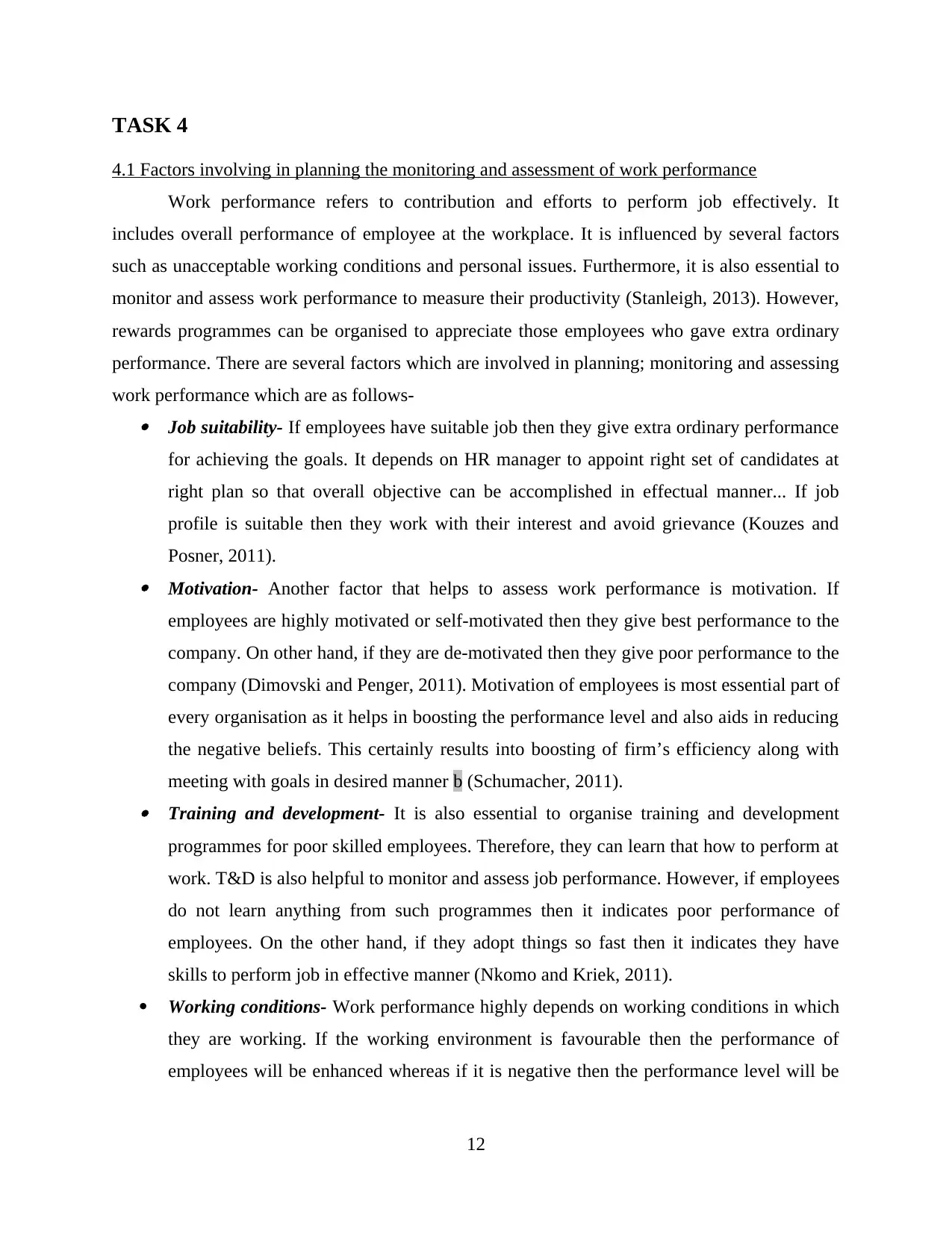
TASK 4
4.1 Factors involving in planning the monitoring and assessment of work performance
Work performance refers to contribution and efforts to perform job effectively. It
includes overall performance of employee at the workplace. It is influenced by several factors
such as unacceptable working conditions and personal issues. Furthermore, it is also essential to
monitor and assess work performance to measure their productivity (Stanleigh, 2013). However,
rewards programmes can be organised to appreciate those employees who gave extra ordinary
performance. There are several factors which are involved in planning; monitoring and assessing
work performance which are as follows- Job suitability- If employees have suitable job then they give extra ordinary performance
for achieving the goals. It depends on HR manager to appoint right set of candidates at
right plan so that overall objective can be accomplished in effectual manner... If job
profile is suitable then they work with their interest and avoid grievance (Kouzes and
Posner, 2011). Motivation- Another factor that helps to assess work performance is motivation. If
employees are highly motivated or self-motivated then they give best performance to the
company. On other hand, if they are de-motivated then they give poor performance to the
company (Dimovski and Penger, 2011). Motivation of employees is most essential part of
every organisation as it helps in boosting the performance level and also aids in reducing
the negative beliefs. This certainly results into boosting of firm’s efficiency along with
meeting with goals in desired manner b (Schumacher, 2011). Training and development- It is also essential to organise training and development
programmes for poor skilled employees. Therefore, they can learn that how to perform at
work. T&D is also helpful to monitor and assess job performance. However, if employees
do not learn anything from such programmes then it indicates poor performance of
employees. On the other hand, if they adopt things so fast then it indicates they have
skills to perform job in effective manner (Nkomo and Kriek, 2011).
Working conditions- Work performance highly depends on working conditions in which
they are working. If the working environment is favourable then the performance of
employees will be enhanced whereas if it is negative then the performance level will be
12
4.1 Factors involving in planning the monitoring and assessment of work performance
Work performance refers to contribution and efforts to perform job effectively. It
includes overall performance of employee at the workplace. It is influenced by several factors
such as unacceptable working conditions and personal issues. Furthermore, it is also essential to
monitor and assess work performance to measure their productivity (Stanleigh, 2013). However,
rewards programmes can be organised to appreciate those employees who gave extra ordinary
performance. There are several factors which are involved in planning; monitoring and assessing
work performance which are as follows- Job suitability- If employees have suitable job then they give extra ordinary performance
for achieving the goals. It depends on HR manager to appoint right set of candidates at
right plan so that overall objective can be accomplished in effectual manner... If job
profile is suitable then they work with their interest and avoid grievance (Kouzes and
Posner, 2011). Motivation- Another factor that helps to assess work performance is motivation. If
employees are highly motivated or self-motivated then they give best performance to the
company. On other hand, if they are de-motivated then they give poor performance to the
company (Dimovski and Penger, 2011). Motivation of employees is most essential part of
every organisation as it helps in boosting the performance level and also aids in reducing
the negative beliefs. This certainly results into boosting of firm’s efficiency along with
meeting with goals in desired manner b (Schumacher, 2011). Training and development- It is also essential to organise training and development
programmes for poor skilled employees. Therefore, they can learn that how to perform at
work. T&D is also helpful to monitor and assess job performance. However, if employees
do not learn anything from such programmes then it indicates poor performance of
employees. On the other hand, if they adopt things so fast then it indicates they have
skills to perform job in effective manner (Nkomo and Kriek, 2011).
Working conditions- Work performance highly depends on working conditions in which
they are working. If the working environment is favourable then the performance of
employees will be enhanced whereas if it is negative then the performance level will be
12
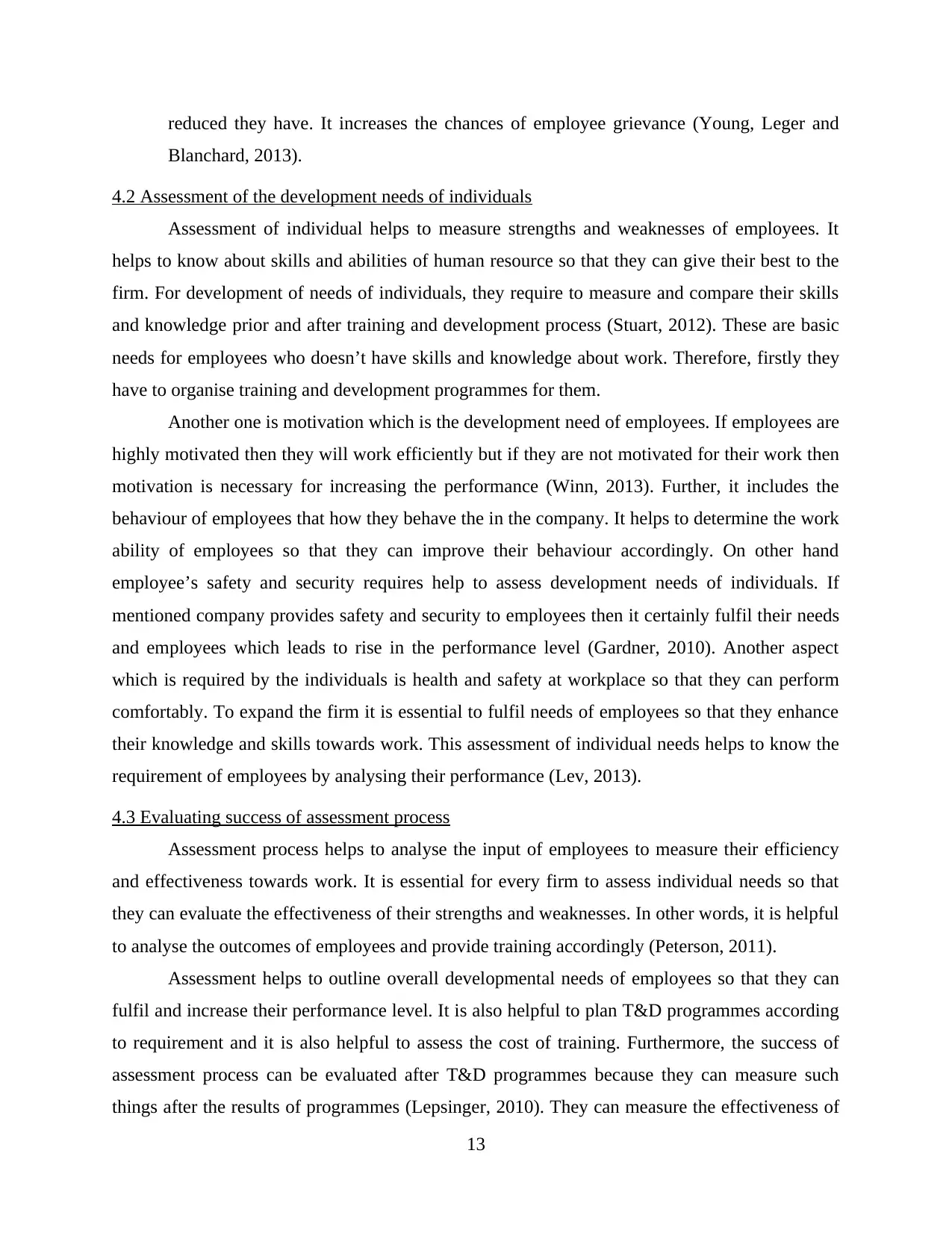
reduced they have. It increases the chances of employee grievance (Young, Leger and
Blanchard, 2013).
4.2 Assessment of the development needs of individuals
Assessment of individual helps to measure strengths and weaknesses of employees. It
helps to know about skills and abilities of human resource so that they can give their best to the
firm. For development of needs of individuals, they require to measure and compare their skills
and knowledge prior and after training and development process (Stuart, 2012). These are basic
needs for employees who doesn’t have skills and knowledge about work. Therefore, firstly they
have to organise training and development programmes for them.
Another one is motivation which is the development need of employees. If employees are
highly motivated then they will work efficiently but if they are not motivated for their work then
motivation is necessary for increasing the performance (Winn, 2013). Further, it includes the
behaviour of employees that how they behave the in the company. It helps to determine the work
ability of employees so that they can improve their behaviour accordingly. On other hand
employee’s safety and security requires help to assess development needs of individuals. If
mentioned company provides safety and security to employees then it certainly fulfil their needs
and employees which leads to rise in the performance level (Gardner, 2010). Another aspect
which is required by the individuals is health and safety at workplace so that they can perform
comfortably. To expand the firm it is essential to fulfil needs of employees so that they enhance
their knowledge and skills towards work. This assessment of individual needs helps to know the
requirement of employees by analysing their performance (Lev, 2013).
4.3 Evaluating success of assessment process
Assessment process helps to analyse the input of employees to measure their efficiency
and effectiveness towards work. It is essential for every firm to assess individual needs so that
they can evaluate the effectiveness of their strengths and weaknesses. In other words, it is helpful
to analyse the outcomes of employees and provide training accordingly (Peterson, 2011).
Assessment helps to outline overall developmental needs of employees so that they can
fulfil and increase their performance level. It is also helpful to plan T&D programmes according
to requirement and it is also helpful to assess the cost of training. Furthermore, the success of
assessment process can be evaluated after T&D programmes because they can measure such
things after the results of programmes (Lepsinger, 2010). They can measure the effectiveness of
13
Blanchard, 2013).
4.2 Assessment of the development needs of individuals
Assessment of individual helps to measure strengths and weaknesses of employees. It
helps to know about skills and abilities of human resource so that they can give their best to the
firm. For development of needs of individuals, they require to measure and compare their skills
and knowledge prior and after training and development process (Stuart, 2012). These are basic
needs for employees who doesn’t have skills and knowledge about work. Therefore, firstly they
have to organise training and development programmes for them.
Another one is motivation which is the development need of employees. If employees are
highly motivated then they will work efficiently but if they are not motivated for their work then
motivation is necessary for increasing the performance (Winn, 2013). Further, it includes the
behaviour of employees that how they behave the in the company. It helps to determine the work
ability of employees so that they can improve their behaviour accordingly. On other hand
employee’s safety and security requires help to assess development needs of individuals. If
mentioned company provides safety and security to employees then it certainly fulfil their needs
and employees which leads to rise in the performance level (Gardner, 2010). Another aspect
which is required by the individuals is health and safety at workplace so that they can perform
comfortably. To expand the firm it is essential to fulfil needs of employees so that they enhance
their knowledge and skills towards work. This assessment of individual needs helps to know the
requirement of employees by analysing their performance (Lev, 2013).
4.3 Evaluating success of assessment process
Assessment process helps to analyse the input of employees to measure their efficiency
and effectiveness towards work. It is essential for every firm to assess individual needs so that
they can evaluate the effectiveness of their strengths and weaknesses. In other words, it is helpful
to analyse the outcomes of employees and provide training accordingly (Peterson, 2011).
Assessment helps to outline overall developmental needs of employees so that they can
fulfil and increase their performance level. It is also helpful to plan T&D programmes according
to requirement and it is also helpful to assess the cost of training. Furthermore, the success of
assessment process can be evaluated after T&D programmes because they can measure such
things after the results of programmes (Lepsinger, 2010). They can measure the effectiveness of
13
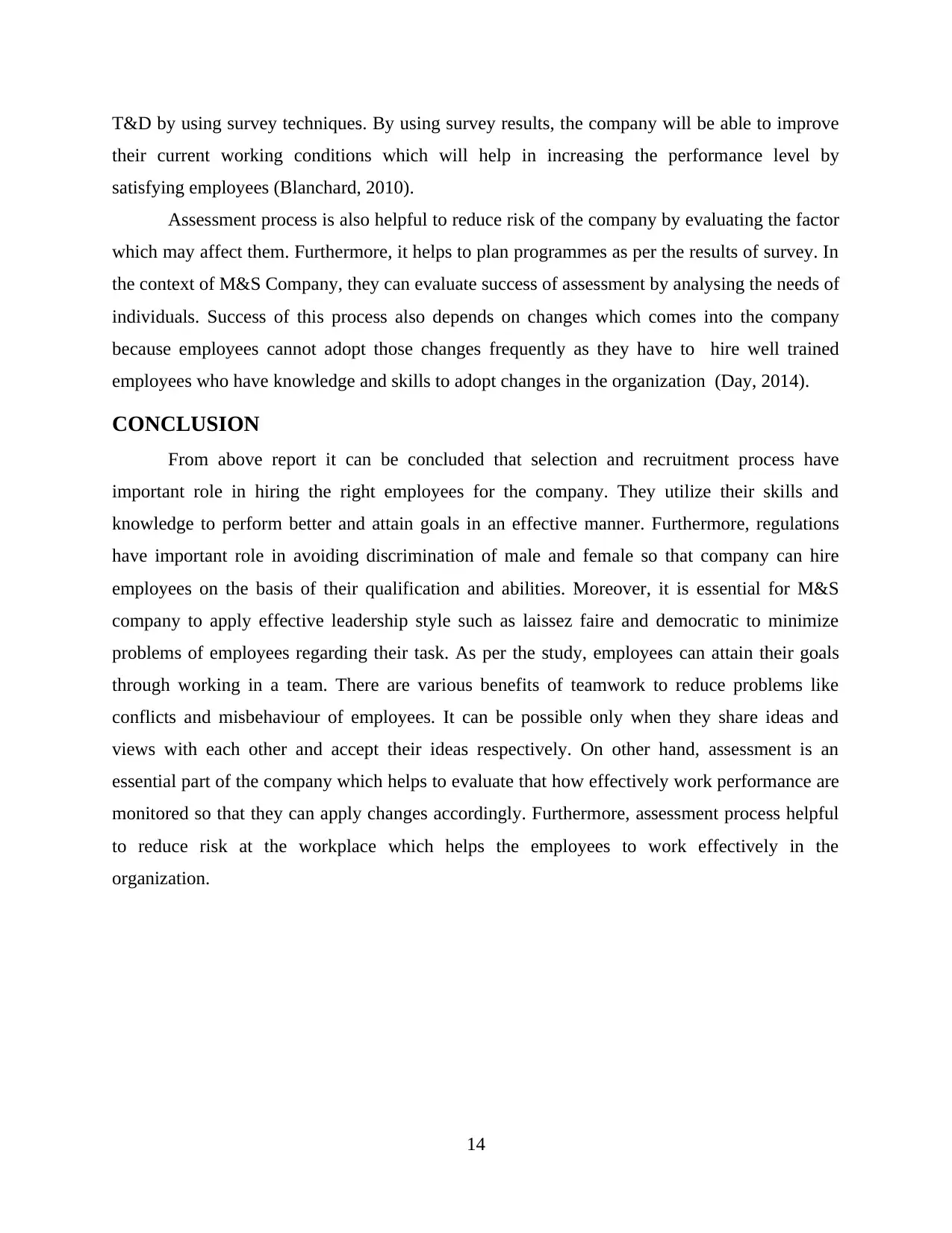
T&D by using survey techniques. By using survey results, the company will be able to improve
their current working conditions which will help in increasing the performance level by
satisfying employees (Blanchard, 2010).
Assessment process is also helpful to reduce risk of the company by evaluating the factor
which may affect them. Furthermore, it helps to plan programmes as per the results of survey. In
the context of M&S Company, they can evaluate success of assessment by analysing the needs of
individuals. Success of this process also depends on changes which comes into the company
because employees cannot adopt those changes frequently as they have to hire well trained
employees who have knowledge and skills to adopt changes in the organization (Day, 2014).
CONCLUSION
From above report it can be concluded that selection and recruitment process have
important role in hiring the right employees for the company. They utilize their skills and
knowledge to perform better and attain goals in an effective manner. Furthermore, regulations
have important role in avoiding discrimination of male and female so that company can hire
employees on the basis of their qualification and abilities. Moreover, it is essential for M&S
company to apply effective leadership style such as laissez faire and democratic to minimize
problems of employees regarding their task. As per the study, employees can attain their goals
through working in a team. There are various benefits of teamwork to reduce problems like
conflicts and misbehaviour of employees. It can be possible only when they share ideas and
views with each other and accept their ideas respectively. On other hand, assessment is an
essential part of the company which helps to evaluate that how effectively work performance are
monitored so that they can apply changes accordingly. Furthermore, assessment process helpful
to reduce risk at the workplace which helps the employees to work effectively in the
organization.
14
their current working conditions which will help in increasing the performance level by
satisfying employees (Blanchard, 2010).
Assessment process is also helpful to reduce risk of the company by evaluating the factor
which may affect them. Furthermore, it helps to plan programmes as per the results of survey. In
the context of M&S Company, they can evaluate success of assessment by analysing the needs of
individuals. Success of this process also depends on changes which comes into the company
because employees cannot adopt those changes frequently as they have to hire well trained
employees who have knowledge and skills to adopt changes in the organization (Day, 2014).
CONCLUSION
From above report it can be concluded that selection and recruitment process have
important role in hiring the right employees for the company. They utilize their skills and
knowledge to perform better and attain goals in an effective manner. Furthermore, regulations
have important role in avoiding discrimination of male and female so that company can hire
employees on the basis of their qualification and abilities. Moreover, it is essential for M&S
company to apply effective leadership style such as laissez faire and democratic to minimize
problems of employees regarding their task. As per the study, employees can attain their goals
through working in a team. There are various benefits of teamwork to reduce problems like
conflicts and misbehaviour of employees. It can be possible only when they share ideas and
views with each other and accept their ideas respectively. On other hand, assessment is an
essential part of the company which helps to evaluate that how effectively work performance are
monitored so that they can apply changes accordingly. Furthermore, assessment process helpful
to reduce risk at the workplace which helps the employees to work effectively in the
organization.
14
Secure Best Marks with AI Grader
Need help grading? Try our AI Grader for instant feedback on your assignments.

REFERENCES
Books and Journal
Mendenhall, M. E. and Osland, J., 2012. Global leadership: Research, practice, and
development. Routledge.
Lev, A. I., 2013. Transgender emergence: Therapeutic guidelines for working with gender-
variant people and their families. Routledge.
Bush, T. and Middlewood, D., 2013. Leading and managing people in education. Sage.
Peterson, B., 2011. Cultural intelligence: A guide to working with people from other cultures.
Nicholas Brealey Publishing.
Offstein, E. H., Morwick, J. M. and Koskinen, L., 2010. Making telework work: leading people
and leveraging technology for competitive advantage. Strategic HR Review .9(2). pp.32-
37.
Shawchuck, N. and Heuser, R., 2010. Leading the congregation: Caring for yourself while
serving the people. Abingdon Press.
Lepsinger, R., 2010. Virtual team success: A practical guide for working and leading from a
distance. John Wiley & Sons.
William P. Robinson, 2010. Leading people from the middle: The universal mission of heart and
mind. iUniverse.
Day, R. D., 2014. Leading and managing people in the dynamic organization. Psychology Press.
Goffee, R. and Jones, G., 2013. Clever: Leading your smartest, most creative people. Harvard
Business Press.
Blanchard, K. H., 2010. Leading at a higher level: Blanchard on leadership and creating high
performing organizations. FT Press.
Kotter, J., 2012. The 8-step process for leading change. Kotter International.
Hamson, N., 2012. After Atlantis: Working, managing, and leading in turbulent times.
Routledge.
Goleman, D., 2010. Why leading sustainability matters more than ever. People & Strategy.
33(1). pp.7-9.
15
Books and Journal
Mendenhall, M. E. and Osland, J., 2012. Global leadership: Research, practice, and
development. Routledge.
Lev, A. I., 2013. Transgender emergence: Therapeutic guidelines for working with gender-
variant people and their families. Routledge.
Bush, T. and Middlewood, D., 2013. Leading and managing people in education. Sage.
Peterson, B., 2011. Cultural intelligence: A guide to working with people from other cultures.
Nicholas Brealey Publishing.
Offstein, E. H., Morwick, J. M. and Koskinen, L., 2010. Making telework work: leading people
and leveraging technology for competitive advantage. Strategic HR Review .9(2). pp.32-
37.
Shawchuck, N. and Heuser, R., 2010. Leading the congregation: Caring for yourself while
serving the people. Abingdon Press.
Lepsinger, R., 2010. Virtual team success: A practical guide for working and leading from a
distance. John Wiley & Sons.
William P. Robinson, 2010. Leading people from the middle: The universal mission of heart and
mind. iUniverse.
Day, R. D., 2014. Leading and managing people in the dynamic organization. Psychology Press.
Goffee, R. and Jones, G., 2013. Clever: Leading your smartest, most creative people. Harvard
Business Press.
Blanchard, K. H., 2010. Leading at a higher level: Blanchard on leadership and creating high
performing organizations. FT Press.
Kotter, J., 2012. The 8-step process for leading change. Kotter International.
Hamson, N., 2012. After Atlantis: Working, managing, and leading in turbulent times.
Routledge.
Goleman, D., 2010. Why leading sustainability matters more than ever. People & Strategy.
33(1). pp.7-9.
15

Miller, W. R. and Rollnick, S., 2012. Motivational interviewing: Helping people change.
Guilford press.
Kuroda, K., Yuki, T. and Kang, K., 2010. Cross-Border Higher Education for Regional
Integration: Analysis of the JICA-RI Survey on Leading Universities in East Asia. JICA-
RI Working Paper. No. 26. Online Submission.
Gwyer, R., 2010. Leading in difficult times: what can we learn from the literature?. New review
of information networking .15(1). pp.4-15.
McKimm, J., 2011. Leading for collaboration and partnership working (pp. 44-9). Oxford:
Blackwell Publishing.
Offstein, E. and Morwick, J., 2011. Making Telework Work: Leading People and Leveraging
Technology for High-Impact Results. Nicholas Brealey Publishing.
Arroba, P. and et.al., 2011. A methodology for developing accessible mobile platforms over
leading devices for visually impaired people. In Ambient Assisted Living (pp. 209-215).
Springer Berlin Heidelberg.
Whitney, D., Trosten-Bloom, A. and Rader, K., 2010. Leading positive performance: a
conversation about appreciative leadership. Performance Improvement .49(3). p.5.
Fraley, R.C. and et.al ., 2011. The experiences in close relationships—Relationship Structures
Questionnaire: A method for assessing attachment orientations across relationships.
Psychological assessment .23(3). p.615.
McSherry, R. and Warr, J., 2010. Implementing Excellence In Your Health Care Organization:
Managing, Leading And Collaborating: managing, leading and collaborating. McGraw-
Hill Education (UK).
Pritchard, K. and Bloomfield, E., 2013. Tackling the challenges of leading through change.
Strategic HR Review .13(1). pp.16-19.
Stanleigh, M., 2013. Leading change. The Journal for Quality and Participation.36(2). p.39.
Kouzes, J.M. and Posner, B.Z., 2011. Credibility: How leaders gain and lose it, why people
demand it (Vol. 244). John Wiley & Sons.
Dimovski, V. and Penger, S., 2011. Virtual Management: A Cross-Section Of The Management
Process Illustrating Its Fundamental Functions Of Planning, Orga-nizing, Leading And
Controlling In A New Era Organization. Journal of Business & Economics Research
(JBER).1(10).
Schumacher, E. F., 2011. Small is beautiful: a study of economics as if people mattered. Random
House.
16
Guilford press.
Kuroda, K., Yuki, T. and Kang, K., 2010. Cross-Border Higher Education for Regional
Integration: Analysis of the JICA-RI Survey on Leading Universities in East Asia. JICA-
RI Working Paper. No. 26. Online Submission.
Gwyer, R., 2010. Leading in difficult times: what can we learn from the literature?. New review
of information networking .15(1). pp.4-15.
McKimm, J., 2011. Leading for collaboration and partnership working (pp. 44-9). Oxford:
Blackwell Publishing.
Offstein, E. and Morwick, J., 2011. Making Telework Work: Leading People and Leveraging
Technology for High-Impact Results. Nicholas Brealey Publishing.
Arroba, P. and et.al., 2011. A methodology for developing accessible mobile platforms over
leading devices for visually impaired people. In Ambient Assisted Living (pp. 209-215).
Springer Berlin Heidelberg.
Whitney, D., Trosten-Bloom, A. and Rader, K., 2010. Leading positive performance: a
conversation about appreciative leadership. Performance Improvement .49(3). p.5.
Fraley, R.C. and et.al ., 2011. The experiences in close relationships—Relationship Structures
Questionnaire: A method for assessing attachment orientations across relationships.
Psychological assessment .23(3). p.615.
McSherry, R. and Warr, J., 2010. Implementing Excellence In Your Health Care Organization:
Managing, Leading And Collaborating: managing, leading and collaborating. McGraw-
Hill Education (UK).
Pritchard, K. and Bloomfield, E., 2013. Tackling the challenges of leading through change.
Strategic HR Review .13(1). pp.16-19.
Stanleigh, M., 2013. Leading change. The Journal for Quality and Participation.36(2). p.39.
Kouzes, J.M. and Posner, B.Z., 2011. Credibility: How leaders gain and lose it, why people
demand it (Vol. 244). John Wiley & Sons.
Dimovski, V. and Penger, S., 2011. Virtual Management: A Cross-Section Of The Management
Process Illustrating Its Fundamental Functions Of Planning, Orga-nizing, Leading And
Controlling In A New Era Organization. Journal of Business & Economics Research
(JBER).1(10).
Schumacher, E. F., 2011. Small is beautiful: a study of economics as if people mattered. Random
House.
16
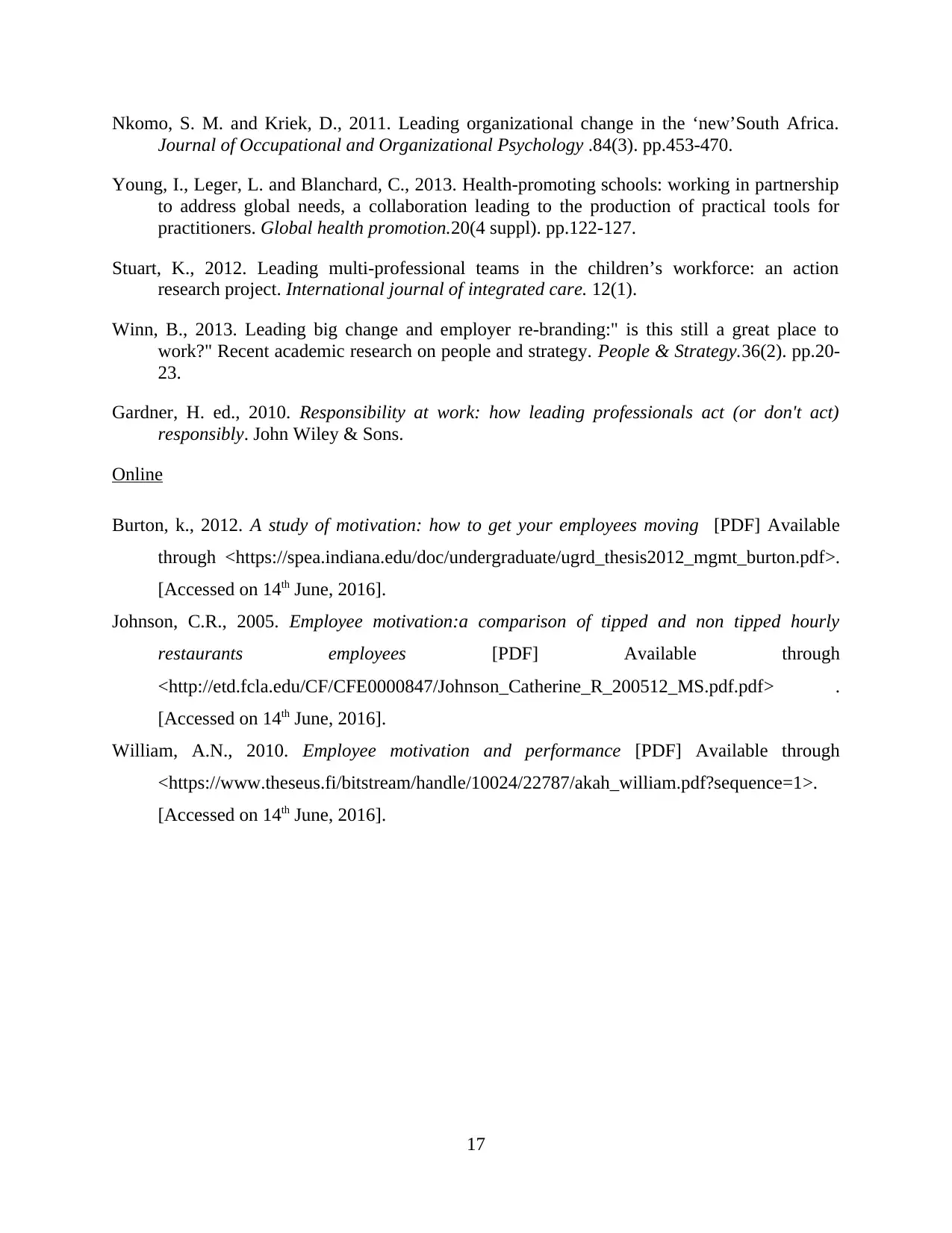
Nkomo, S. M. and Kriek, D., 2011. Leading organizational change in the ‘new’South Africa.
Journal of Occupational and Organizational Psychology .84(3). pp.453-470.
Young, I., Leger, L. and Blanchard, C., 2013. Health-promoting schools: working in partnership
to address global needs, a collaboration leading to the production of practical tools for
practitioners. Global health promotion.20(4 suppl). pp.122-127.
Stuart, K., 2012. Leading multi-professional teams in the children’s workforce: an action
research project. International journal of integrated care. 12(1).
Winn, B., 2013. Leading big change and employer re-branding:" is this still a great place to
work?" Recent academic research on people and strategy. People & Strategy.36(2). pp.20-
23.
Gardner, H. ed., 2010. Responsibility at work: how leading professionals act (or don't act)
responsibly. John Wiley & Sons.
Online
Burton, k., 2012. A study of motivation: how to get your employees moving [PDF] Available
through <https://spea.indiana.edu/doc/undergraduate/ugrd_thesis2012_mgmt_burton.pdf>.
[Accessed on 14th June, 2016].
Johnson, C.R., 2005. Employee motivation:a comparison of tipped and non tipped hourly
restaurants employees [PDF] Available through
<http://etd.fcla.edu/CF/CFE0000847/Johnson_Catherine_R_200512_MS.pdf.pdf> .
[Accessed on 14th June, 2016].
William, A.N., 2010. Employee motivation and performance [PDF] Available through
<https://www.theseus.fi/bitstream/handle/10024/22787/akah_william.pdf?sequence=1>.
[Accessed on 14th June, 2016].
17
Journal of Occupational and Organizational Psychology .84(3). pp.453-470.
Young, I., Leger, L. and Blanchard, C., 2013. Health-promoting schools: working in partnership
to address global needs, a collaboration leading to the production of practical tools for
practitioners. Global health promotion.20(4 suppl). pp.122-127.
Stuart, K., 2012. Leading multi-professional teams in the children’s workforce: an action
research project. International journal of integrated care. 12(1).
Winn, B., 2013. Leading big change and employer re-branding:" is this still a great place to
work?" Recent academic research on people and strategy. People & Strategy.36(2). pp.20-
23.
Gardner, H. ed., 2010. Responsibility at work: how leading professionals act (or don't act)
responsibly. John Wiley & Sons.
Online
Burton, k., 2012. A study of motivation: how to get your employees moving [PDF] Available
through <https://spea.indiana.edu/doc/undergraduate/ugrd_thesis2012_mgmt_burton.pdf>.
[Accessed on 14th June, 2016].
Johnson, C.R., 2005. Employee motivation:a comparison of tipped and non tipped hourly
restaurants employees [PDF] Available through
<http://etd.fcla.edu/CF/CFE0000847/Johnson_Catherine_R_200512_MS.pdf.pdf> .
[Accessed on 14th June, 2016].
William, A.N., 2010. Employee motivation and performance [PDF] Available through
<https://www.theseus.fi/bitstream/handle/10024/22787/akah_william.pdf?sequence=1>.
[Accessed on 14th June, 2016].
17
1 out of 19
Related Documents
Your All-in-One AI-Powered Toolkit for Academic Success.
+13062052269
info@desklib.com
Available 24*7 on WhatsApp / Email
![[object Object]](/_next/static/media/star-bottom.7253800d.svg)
Unlock your academic potential
© 2024 | Zucol Services PVT LTD | All rights reserved.





